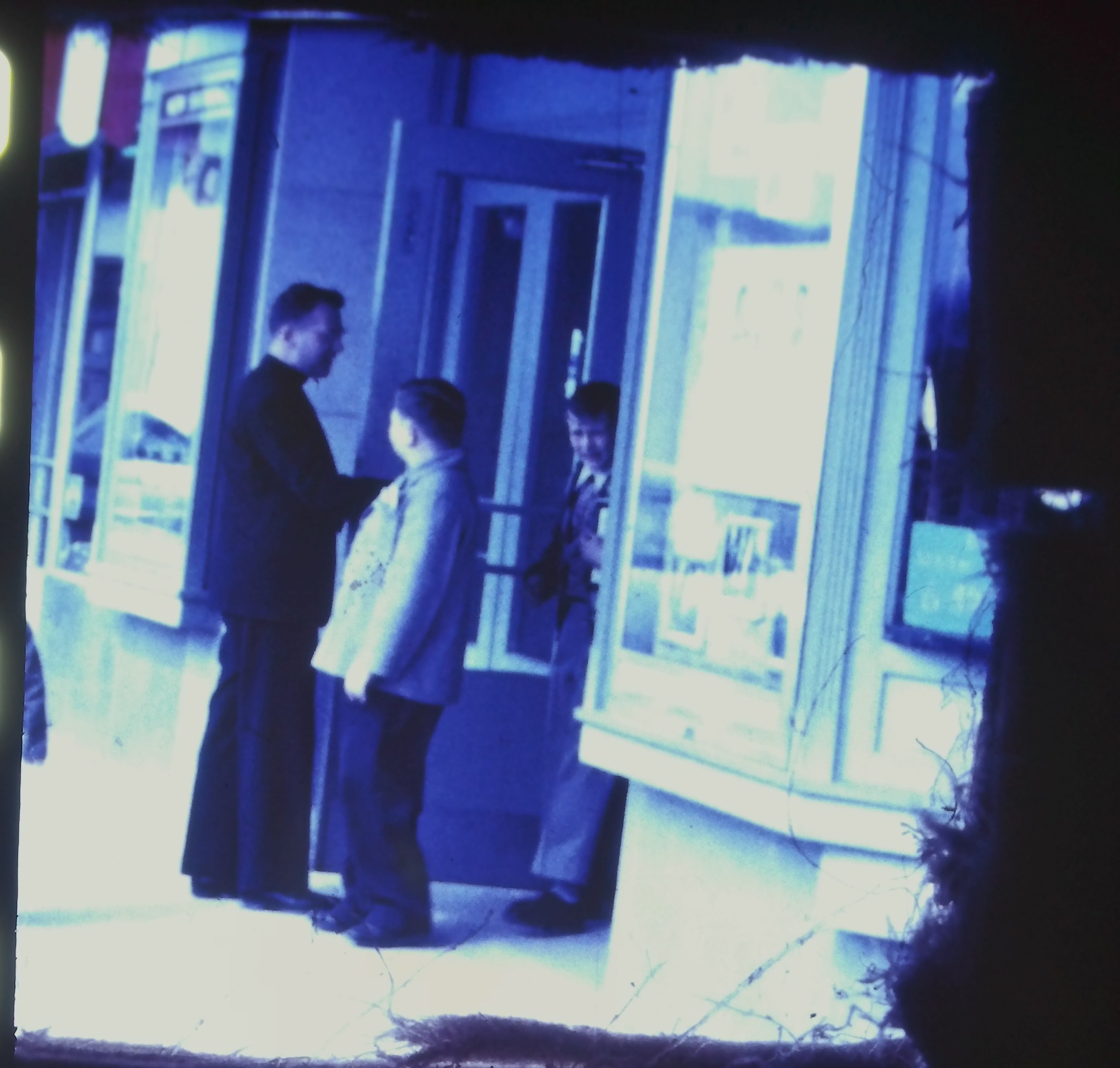HOLY TRINITY HISTORY
1940’s Launch of New Church
The 1940 census for Fairfax County and Falls Church City showed populations of 40,929 and 2,576 respectively. Most of the area west of Falls Church City except for older incorporated towns was a sparsely populated semi-rural area. However, with the New Deal economics brought about by FDR and a Democratic Congress followed by the buildup surrounding World War II, the Washington, DC area and especially Northern Virginia exploded in new economic opportunities and thus huge population growth. With this in mind, the new housing developments south and west of Falls Church City needed churches to meet the religious affiliations for these new emigrants.
Holy Trinity Lutheran Church had its beginnings in the late 1940's when Pastor Robert W. Long of Faith Lutheran Church, Arlington, VA, proposed to Dr. Walter E. Schuette, President of the Eastern District of the American Lutheran Church, the organization of a mission congregation in the then rural area of Falls Church, VA. As a result, in the fall of 1947, the American Lutheran Church purchased three lots at the corner of Arlington Boulevard and Woodlawn Avenue, and in the spring of 1948, Dr. Schuette and Faith Lutheran Church jointly extended a call to Rev. Edward F. Yost to serve as a temporary assistant at Faith Lutheran Church for the purpose of developing the new mission church.
Initial quarters were in the Hillwood Square Community Hall, a temporary war housing project on Defense Walk near Cherry Street in Falls Church. Pastor Yost, a large number of members from Faith Lutheran Church and others who lived in the new mission area, served as the nucleus for the new congregation, Jefferson Village Church.
1948-The first service
On July 26, 1948, President Truman issued Executive Orders mandating desegregation of the U.S. military and the federal workforce. In August 1948, Falls Church City legally became a second class city under Virginia state law and changed its boundaries and name to City of Falls Church. Jefferson Village Lutheran Church held its first Sunday service on September 12, 1948, in the Hillwood Square Community Hall close to the intersection of Cherry Street and Defense Drive (now Avalon Apartments). Forty persons attended this first service with twenty-one children in Sunday School. The hymnal used was the 1930 edition of the American Lutheran Hymnal. The church bulletin was two pages. Fairfax County Public Schools and City of Falls Church Public Schools were segregated.
Median annual family income was $3,200. A loaf of bread cost 11 cents. Soon to be completed homes just southwest of Jefferson Village Lutheran Church in Westlawn would be sold for $8,900 (less than three times the median annual family income). Miracle on 34th Street was a top movie. The Ed Sullivan Show premiered in 1948. Harry S. Truman won the Presidential election with 24 million votes. Third party candidate, Strom Thurmond, a Dixiecrat, won four states in the Deep South. “All I Want for Christmas (Is My Two Front Teeth)” was the top song in December 1948. The Cleveland Indians won the first World Series widely broadcast on television.
Internationally, Gandhi was assasinated, Communists seized power in Czechoslovakia, modern day Israel was established and immediately was at war with its Arab neighbors, and the Berlin Airlift occurred.
1949- Use of Jefferson theater
On Monday evening, January 24, 1949, Jefferson Village Lutheran Church was formally organized as Holy Trinity Lutheran Church (HTLC) with Rev. Yost as its pastor and with 21 charter members mainly from Faith Lutheran Church. George Cooper was the first president of the congregation. The Women of the Church were organized on January 25, 1949. This was the first group established at HTLC. On February 9, 1949, 13 families from Faith Lutheran Church including Rev. Yost were officially transferred to HTLC. An adult choir began in 1949.
The congregation saw rapid growth. Thus, on Easter Sunday, April 17, 1949, HTLC moved its Sunday services to the newly opened Jefferson Theater (Entry was through what is now Baskin-Robbins Ice Cream Parlor and the church was in the Goodwill store) close to the crossroads of Annandale Road and Arlington Boulevard. 103 persons attended (39 person membership) with 60 in Sunday School.
1950’s The Beginning Years
1950-purchasing the land
The 1950 census for Fairfax County and the City of Falls Church showed populations of 98,255 and 7,534. These were increases from the 1940 census of 140% and 192%. The Brotherhood (a men’s group) began in January 1950. Two children’s choirs began in 1950.
Funding of $45,000 for a permanent location and church building for HTLC was secured by the Eastern District of the American Lutheran Church (ALC) and neighboring ALC congregations. The location of HTLC would be on Woodlawn Avenue and Lee Boulevard (now Arlington Boulevard). The Deed for lots 157, 158, and 159 of the City Park Homes, Section 3 development was recorded on November 21, 1950 in Deed Book 812, at page 33. A shameful note must be made that restrictions in the recorded deed explicitly stated only Caucasians were allowed to use, occupy, sell, or buy the land and buildings of HTLC.
The Women of the Church were organized on January 25, 1949, the first group established at Holy Trinity. An adult choir began in 1949, and two children’s vocal choirs started in 1950. The Brotherhood (a men’s group) began in January 1950, while Luther League began in 1951 as did Boy Scout Troop 140. The first Confirmation Class was formed in 1952.
Groundbreaking for the church building was on March 4, 1951. The first worship service, a special Thanksgiving Service, was celebrated in the basement assembly room (still under construction) on November 21, 1951. On December 9, 1951, the church building was dedicated and consecrated. Communicant membership was now 117. The first Confirmation Class was formed in 1952. The first kindergarten class of 29 pupils graduated in 1953.
Holy Trinity has a deep sense of admiration for the young men of our community who have been members of Boy Scout Troop 140. It has sponsored the Troop since 1951. From 1950 to 2002, 41 young men passed the Board of Review and become Eagle Scouts. The troop continues to meet at Holy Trinity to this day.
The first parsonage was purchased on Westmoreland Road on March 23, 1952. On the fifth anniversary of HTLC’s establishment, the church officially moved from mission church status to full church status in the Eastern District of the ALC. Most of the single-family homes around HTLC were built from the late 1940s through the 1950s with expansion moving westward in Fairfax County. Correspondingly, HTLC membership and attendance skyrocketed. Membership was now 217 with 350 enrolled in Sunday School. On August 28, 1955, the Education wing of the church building was added (now church offices, conference room, and portions of Building Blocks II downstairs).
The Rothenberg Family: Refugee Sponsorship
In 1952, The Couples Club of Holy Trinity decided to sponsor a refugee family from West Germany; sponsorship was not an easy decision for either the church group or the refugee family as the government imposed strict rules on both parties. On Sunday, April 27, 1952, Herbert and Marie Rothenberg and their three children arrived in Washington, DC. The Holy Trinity sponsors had arranged for a house and work for the family. The Rothenbergs were welcomed by the Holy Trinity congregation on Sunday, May 11, 1952. From that day forward, they began a lifelong association with Holy Trinity that benefitted both the congregation and the family.
January 1, 1954, marked the change from Mission Church to full church status with communicant membership at 217 and Sunday School enrollment at 350. On August 28, 1955, a new two-story education unit (currently the Church office, Bible room, Pastors' Offices, Music and Nursery rooms) was dedicated to accommodate the increasing Sunday School enrollment.
Over the next four years, membership continued to grow, and in September 1959, two additional properties were purchased. The first property was the house immediately across from Holy Trinity at 7019 Aronow Drive. This house was designated as the Parsonage and the Parsonage on Westmoreland Road was sold. The basement of the parsonage was used for additional Sunday School classrooms. The second property was a vacant lot at 7002 Aronow. A new parsonage was built on this property and dedicated on April 29, 1962.
1960’s A New Era
Our Members and Community
The decade of the 1960’s was a time of major accomplishments in the life of Holy Trinity, particularly the construction of the current church, a new parsonage, and the installation of a new organ.
The decade began with Edward Yost as the Pastor, continuing his 15-years of service that began in 1948 and ending in 1963 with his answering a call to a church in Florida. He was succeeded by Pastor William L. Nies; who served Holy Trinity from 1963 to 1974, a period of 11 years. Both Pastors were instrumental in guiding the expansion of the original church building to what exists today.
The 1960 census for Fairfax County and the City of Falls Church showed populations of 275,002 and 10,192. These were increases from the 1950 census of 179% and 35%. This would be the peak percentage increase in census population as the Baby Boom bubble would burst by 1964. Fairfax County continued phenomenal growth, but the residential areas around HTLC were now established neighborhoods.
The congregation had many groups that met regularly, including the following: Church Vestry, Brotherhood (for men), Women of the Church (the first group that was formed), Couples Club, Church School, Junior High League, Senior High League (this league was sometimes referred to as Luther League), Junior Lutherans, Children of the Church, Children’s Choirs, Adult Choir, and Christian Day School (K through 1st grade), Vacation Bible School, the Building Committee, and workshops for church members to make Christmons for the church’s Christmas tree.
In addition to the above mentioned activities, periodic social events were planned, including bowling, congregational potluck dinners, box socials for teens (girls prepared lunch for two and boys bid for lunch with the girls), youth group picnics in Rock Creek Park, Sunday School picnics, and softball games.
The congregation not only nurtured the members of Holy Trinity but they also reached out to those in need. Some of the activities during this decade included participation in a World Day of Prayer at Graham Road Methodist Church, sewing projects for struggling people in New Guinea (Women of the Church), Blood Drives for the Lutheran Blood Bank, financial Support for Chile after a major earthquake, Lutheran Servicemen’s Lounge, and support for the Lutheran Inner Mission Society that focused on social services.
Another shameful note needs to be made about the exclusion of Blacks from neighborhood housing and schools during these early years of HTLC. One of the primary drivers for the City of Falls Church becoming a legal second class city in 1948 was to exclude Blacks from the City of Falls Church and from the city’s public schools.
The 1954 Supreme Court decision of Brown v. Board of Education of Topeka required public schools to integrate. Virginia state and local governments replied with a strategy of massive resistance. “Colored” public schools were established close to HTLC during the 1950s with Luther Jackson High School for Black high school students in all of Fairfax County and James Lee Middle School for Black middle schoolers in our area. Even the newly created streets and public utilities such as street lights and maintained hard surface roads were denied to the area where Black residents lived such as the Tinner Hill area. No documents can be found in HTLC archives to show any pushback from the ALC or HTLC to these blatantly racist and illegal actions.
(By the end of the 1950s the Fairfax County and the City of Falls Church public schools systems were still segregated. Fairfax County Public Schools would not be fully integrated until 1965, eleven years after the Brown v. Board of Education of Topeka decision made segregation illegal.)
Growth of Holy Trinity
In 1961, three church services were scheduled to accommodate the growing membership: 7:30, 8:30, and 11:00 am. Fun Note: At this time, men were encouraged to feel free to remove their jackets in summer when attending church services rather than skip church (there was no air conditioning).
A new parsonage was purchased across from the church at 7019 Aronow Drive and an empty lot was purchased at 7002 Aronow Drive (house built in 1962). The original parsonage on Westmoreland Road was sold. Plans were in development to build a new sanctuary (eventually built in 1963/1964 and dedicated in 1965). Two lots on Wallace Drive were purchased to add sufficient parking for the entire church complex.
On December 16, 1963, the ground-breaking service was held for our current sanctuary and fellowship hall. The cornerstone-laying ceremony was on June 14, 1964 (sealed within the cornerstone is a Bible, List of members, Messenger, $1 bill, and 1, 5, 10, 25 and 50 cent coins). The dedication was held on February 21, 1965. Due to a shortage of funds, the large chancel window over the alter depicting the Holy Trinity was not installed and dedicated until Oct 24, 1965. At this time, baptized membership totaled 1149; confirmed, 641; and Sunday School enrollment 416. The dedication of the new sanctuary marked the completion of the third unit in a building program begun almost 14 years earlier with the breaking of ground for the original chapel. (The apostolic side windows were scheduled to be installed as money became available. However, a large anonymous donation allowed us to accelerate the installation, and the windows were dedicated on April 3, 1966.)
As Holy Trinity’s membership grew during the early 60s, so did its needs for additional staff. To meet this need, Robert Laughlin was hired as a student assistant for 1965. In 1966 the Vicar program was initiated with the internship of Donald McCash. From 1967 to 1969 Timothy Nehls, Richard Gilbert and Richard Browder, students at the Evangelical Lutheran Seminary of Columbus, Ohio, served one year internships at Holy Trinity. By 1970 it was clear that the need for additional pastoral staff could no longer be filled by interns. Thus, Holy Trinity established the position of Assistant Pastor with a call to Douglas Langholz, who was installed on September 13, 1970.
In May 1966 the 8 rank 555 pipe Lewis and Hitchcock pipe organ was dedicated. Due to a shortage of funds only one third of the pipes could be included at that time. During the next 16 years ranks of pipes were gradually added so by May 1982 the completed organ included 24 ranks on 41 stops with 1574 pipes.
Holy Trinity Day School 1952-1970
The Holy Trinity Day School operated as an independently budgeted entity and staff within HTLC for 18 years, opening on September 2, 1952, and closing on June 4, 1970. The purpose of the Day School was to fill a need within the community for a kindergarten as this was not yet available in the area public schools, and for parents who wanted to start their children in school but whose child failed to meet the age cutoff requirement.
Goals of the school program were to offer education with an emphasis on Christian training, cooperation with the parents to better adjust the children to their environment, and to prepare them for continuing education in the area public schools. Parents attended monthly meetings with a special speaker and had time to discuss their children’s progress and problems.
The first year enrollment was limited to a morning and afternoon kindergarten class totaling 30 children with two teachers and an assistant. Following years added a 1st grade class limited to 13 children with a school day of 9am to 2pm. Tuition was $28 per month.
Many people were involved in the school but one in particular stood out, Mrs. Everrett Allsman. Elsie Allsman served on the HTLC Day School board and as principal and 1st grade teacher for seventeen years.
Classes continued to be at full capacity until school year 1966-67 when the local public schools systems began implementing a pilot program of half-day kindergarten. At that time the HTLC Day School added a “Readiness” program for pre-kindergarten aged children with up to 24 four year olds registered. It became apparent during the 1969-70 school year that declining enrollments would no longer make the school economically viable and thus the school closed on June 4, 1970.
An interesting note is that some 48 years after the HTLC Day School closed a new early childhood day school opened once again in the same space occupied by the original HTLC Day School, albeit extensively renovated This time the children were all pre-school aged from six months to five years. This day school is a tenant of HTLC, operating as Building Blocks II under the leadership of Mabel Espinoza. Much has changed in 75 years but the need for HTLC to serve our neighborhood and families has not changed.
(Picture is from the HTLC Day School graduation for school year 1967-68.)
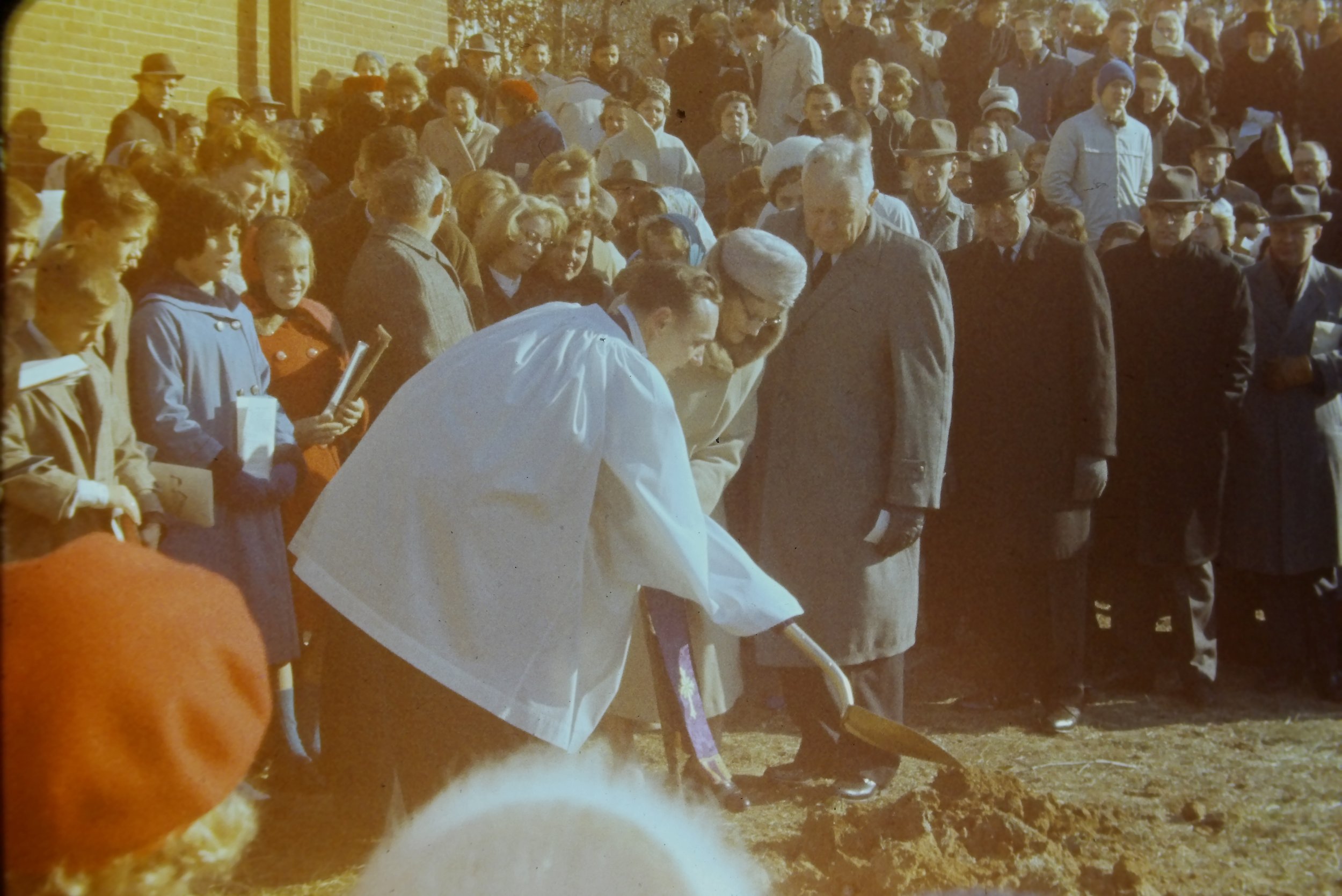
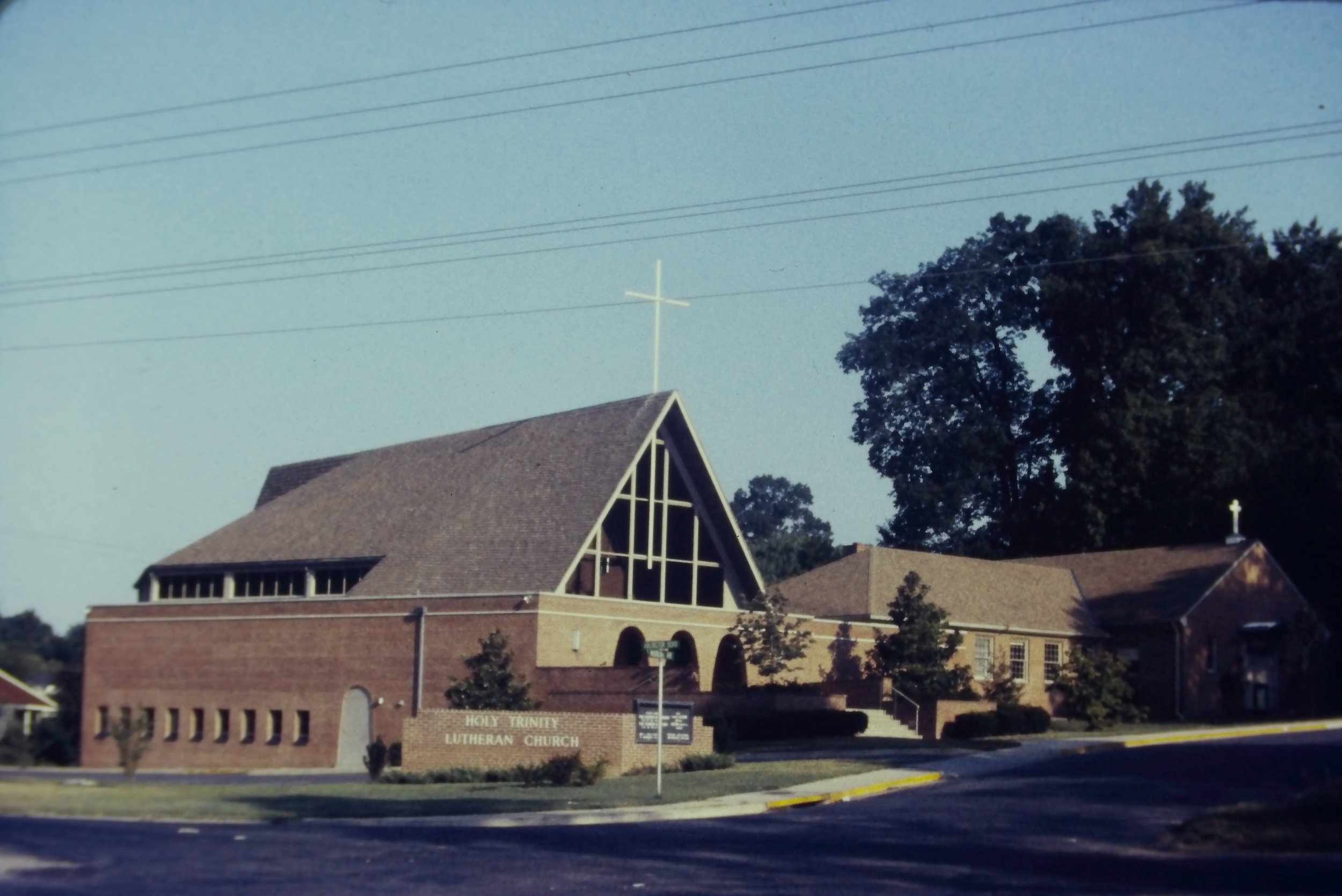
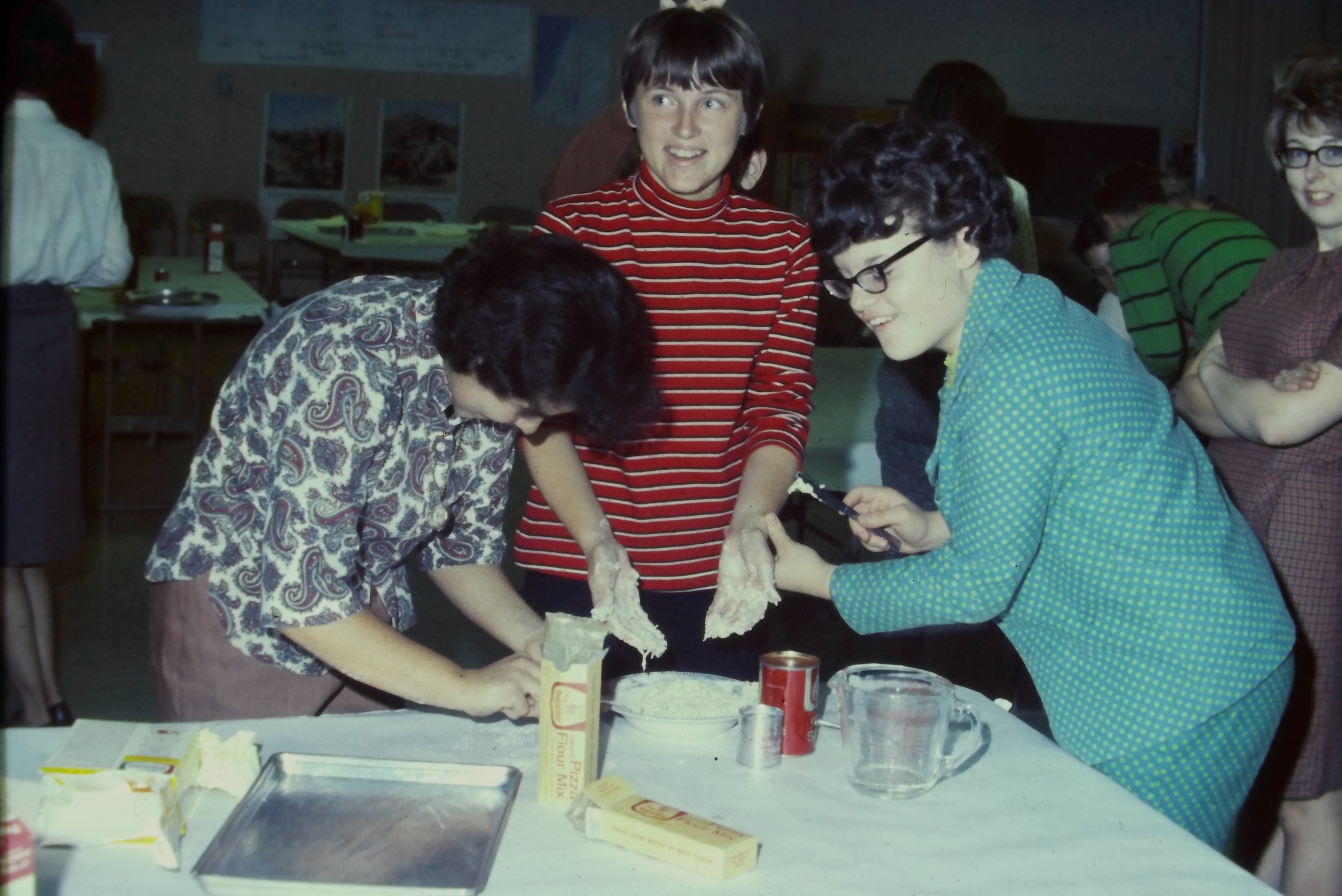
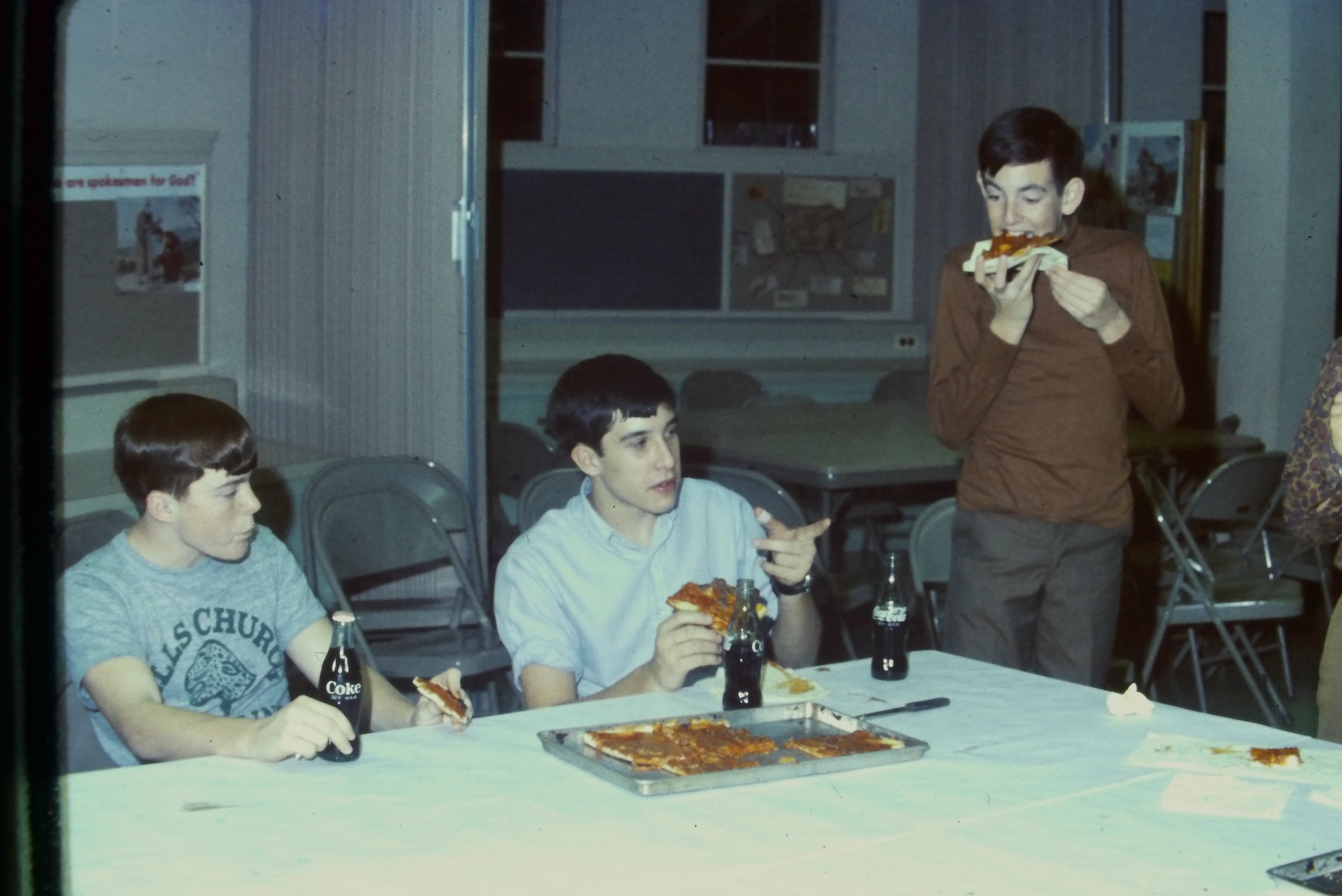
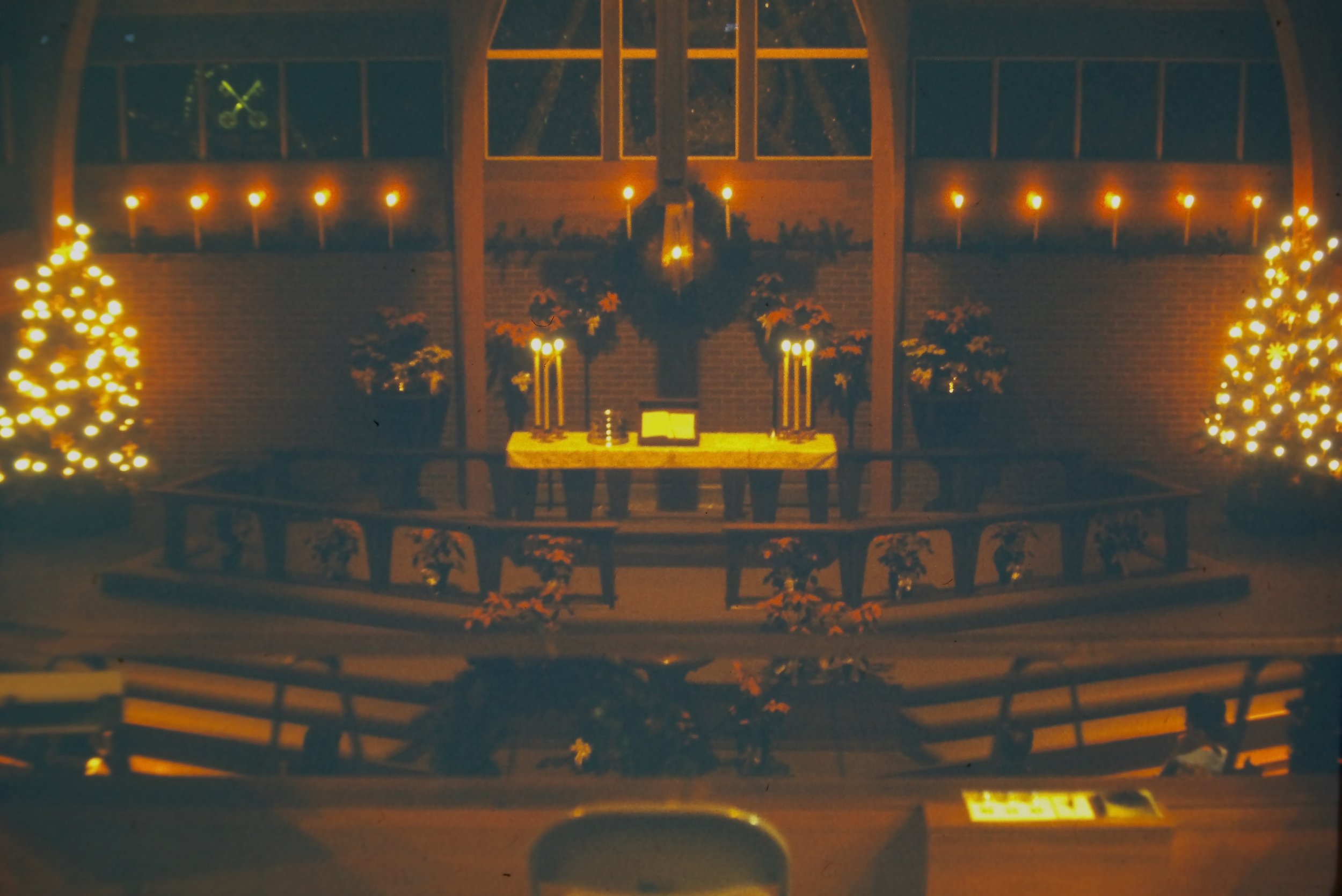
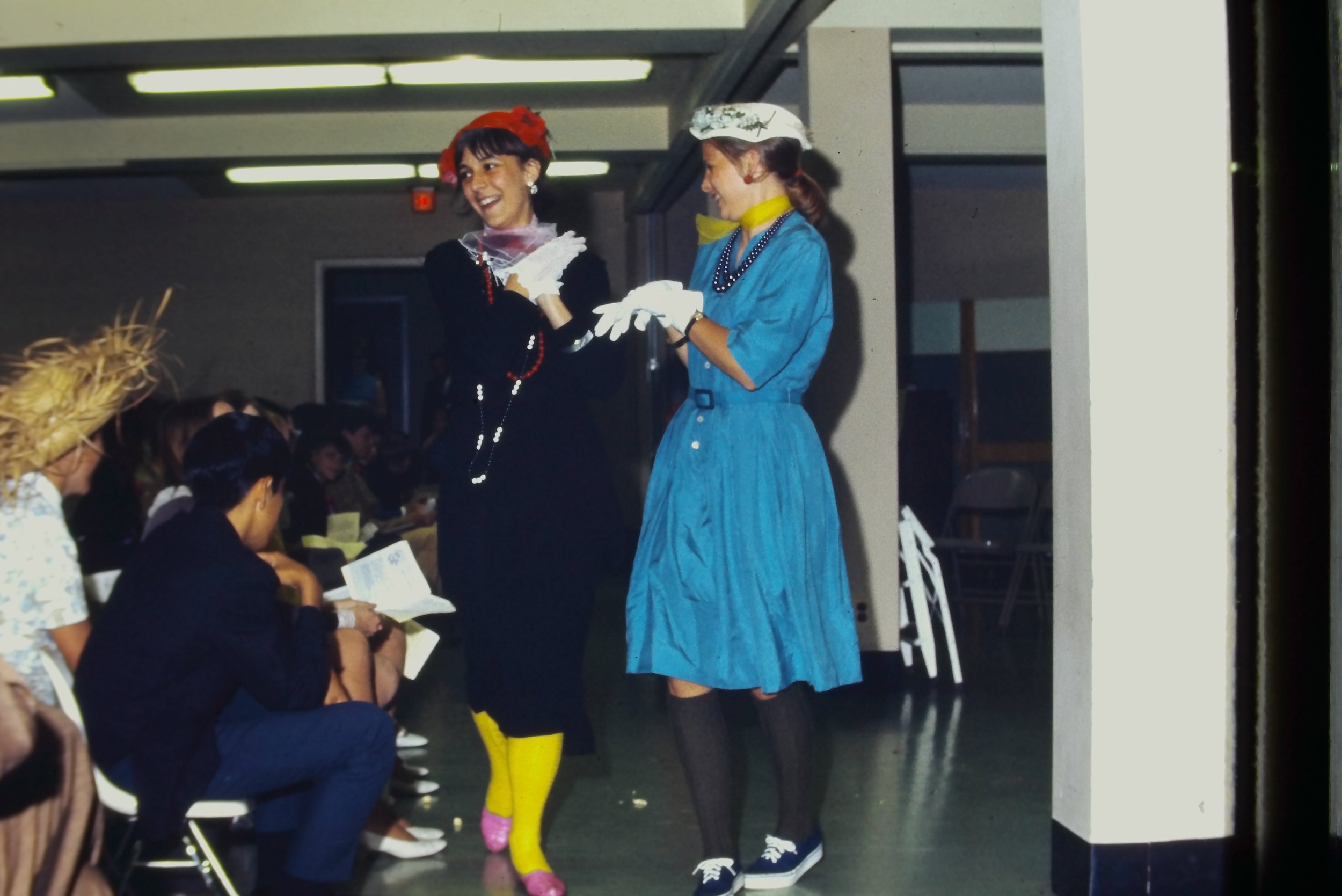
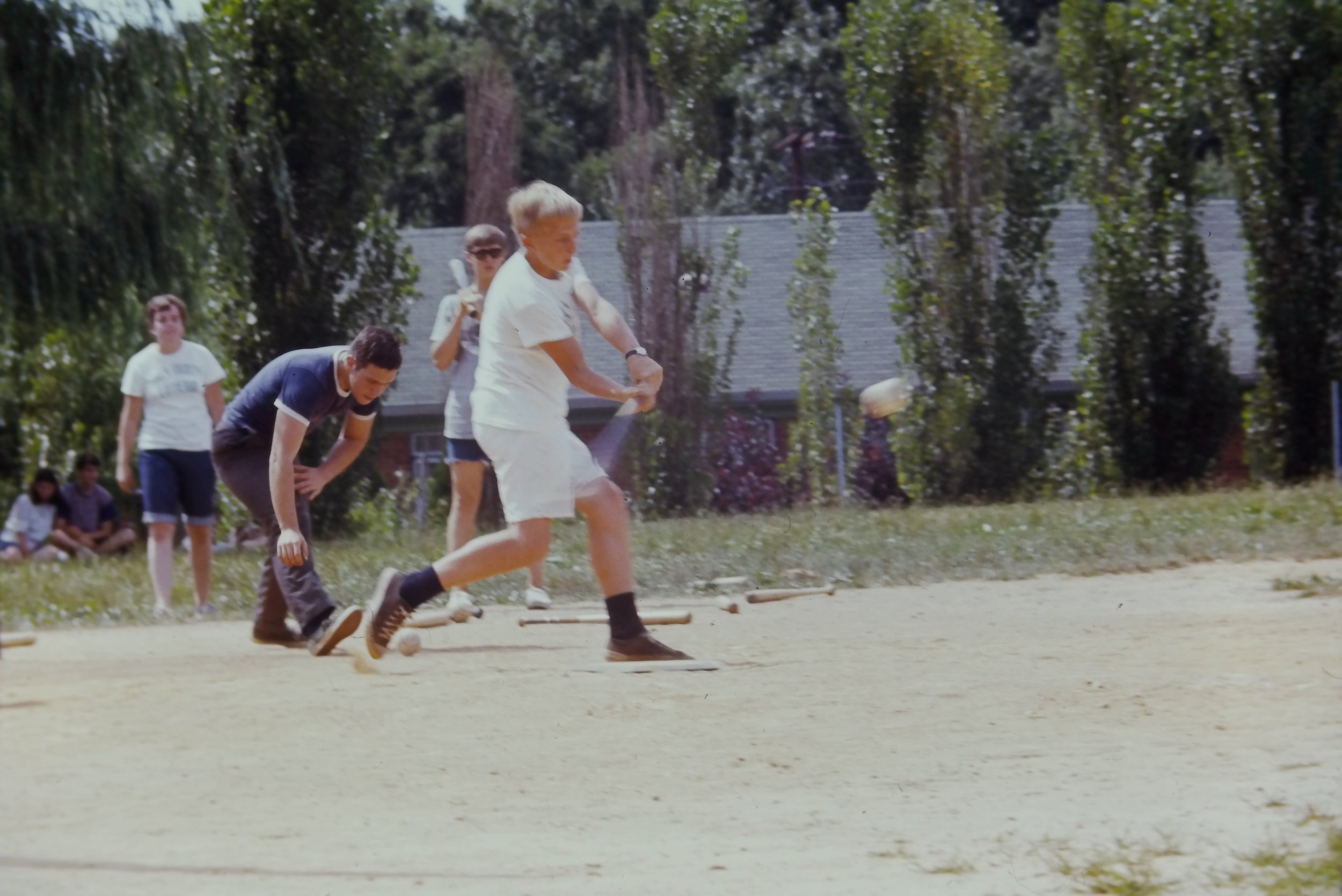



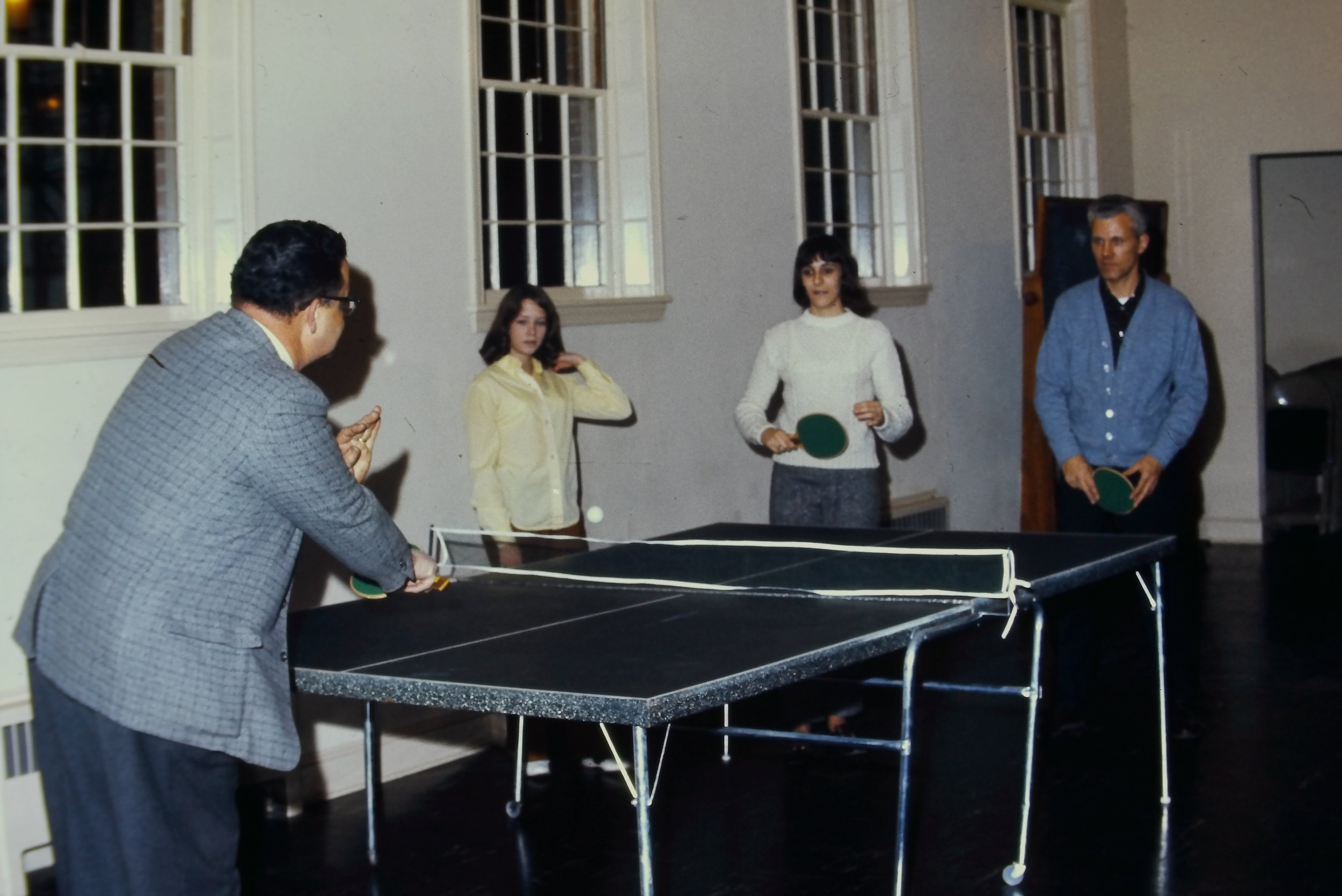
1970’s
Notwithstanding the slowing growth of the area, by the late ‘60’s, the Holy Trinity population was strong and so was their engagement in church activities, as recorded in the Holy Trinity Annual Report for 1969, presented at a congregation dinner and meeting held in January 1970. The following statistics for the year are taken from that report.
Baptisms: 67
Confirmations: 54
Marriages: 19
Funerals: 5
Average Sunday worship attendence (2 services): 652
Day School: 40
Sunday School (2 Sessions): 540
Vacation Bible School (summer): 454
Junior Choir: 50 Members
Youth Choir: 35 Members
Adult Choir: 50 Members
1970’s reports indicate: that the church had chancel dramas at mid-week services during lent, members visited Powhattan Nursing Home to conduct devotions, the church celebrated its 20th anniversary, Holy Trinity brochures were distributed to over 200 apartments and 17 local hotels by the evangelism committee, and adult education focused on sociological problems and the Christain disipline.
On November 6, 1974, after serving Holy Trinity for 11 years, Pastor William Nies accepted a Call to South Miami Lutheran Church, Miami, Florida. Pastor Langholz was called to be Senior Pastor and was installed on May 18, 1975. Stephen DeGweck was installed as Assistant Pastor on August 31, 1975. On August 13, 1978, after serving Holy Trinity for 3 years, Pastor DeGweck resigned as Assistant Pastor to serve as U.S. Air Force Chaplin at Dyess Air Force Base, Abilene, Texas. Steven Swonger was installed as Assistant Pastor on September 17, 1978.
THE HANDBELL PROGRAM
Holy Trinity’s Handbell Program started in the fall of 1975 with two octaves of Schulmerich Handbells, 25 bells. Gretchen Shoemaker directed the adults and Kay Slocum directed the children. Current Christus Bells members--Jan Martin, Tom Gannon, and Marilyn Gannon--were part of the original choir. By 1977 the program had four octaves of bells, 49 bells. Irmingard Zahn then directed the adults plus Ruth Suddarth and Leslie King directed the children’s choirs.
Luther League
Luther League was a prominent youth group for teens at Holy Trinity in the 1970s. They prayed, studied, worshipped, and worked hard to learn a lot of great music. Under the direction of Kay Slocum, they formed a group called, “Get Together.” The group performed in coffee houses around the area, and had the amazing experience of putting on a full production of Godspell, complete with original script and all of the music. They visited a neighborhood nursing home once a month to perform and sang in the choir every Sunday. Luther League also attended semi-annual retreats at Caroline Furnace where the teens shared fellowship and immense joy in being together in the beautiful outdoors.
Luther League frequently spent their time together outside of “church” sponsored activities, even though the 12-20 youth represented close to half a dozen area high schools. One of their favorite weekend ‘sports’, was to ‘tee pee’ the homes of their beloved youth sponsors and pastor. They regularly covered the homes of Jan and Barb Allsman and the house across the street from the church, which, at that time, was the parsonage.
In the late 1970’s, Luther League was led by Steve DGweck. Under the leadership of DGweck and a few member sposnors, the youth created “Son Country,” a sensational music group. They performed all over Northern Virginia and at a Lutheran youth convention in Kansas City in 1979.
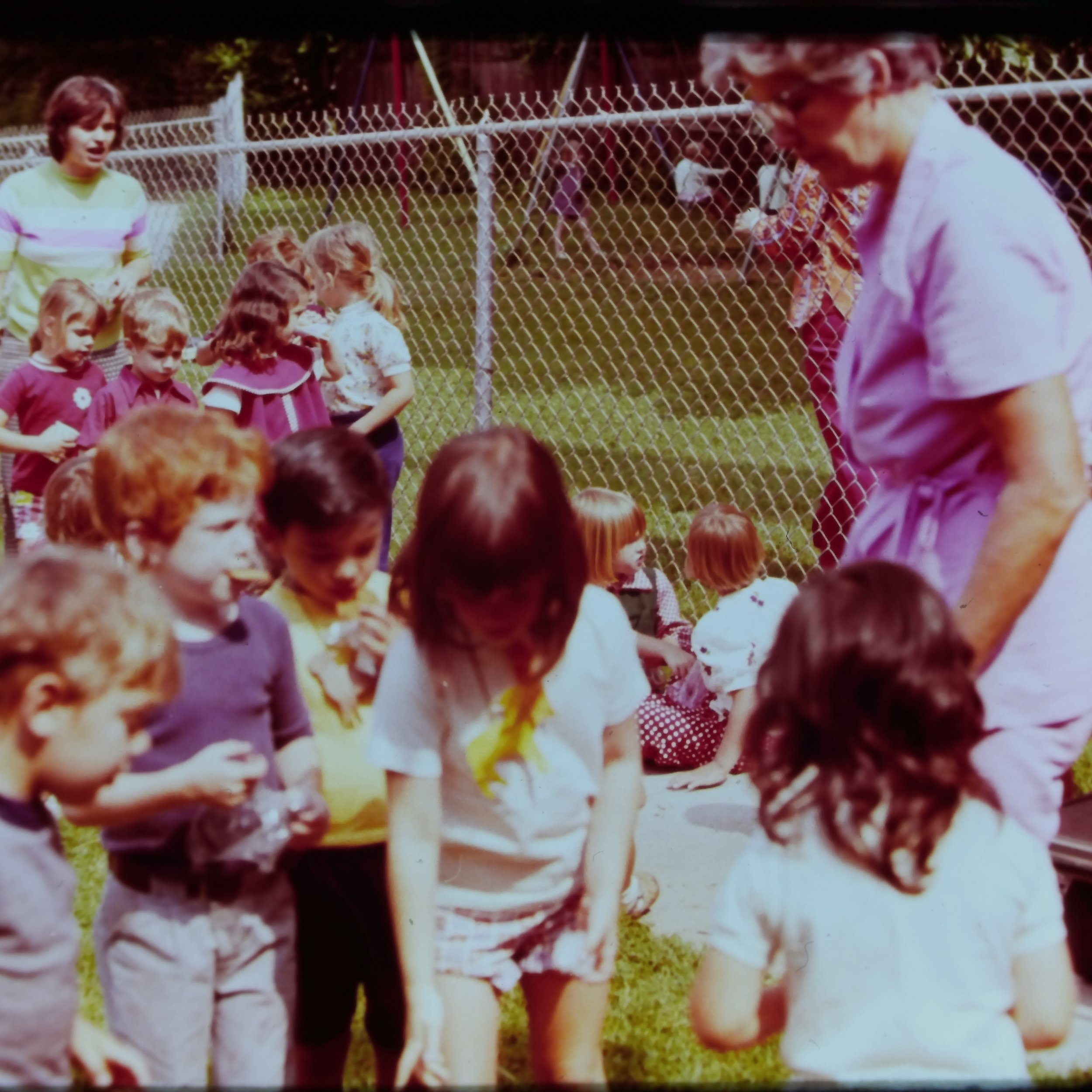
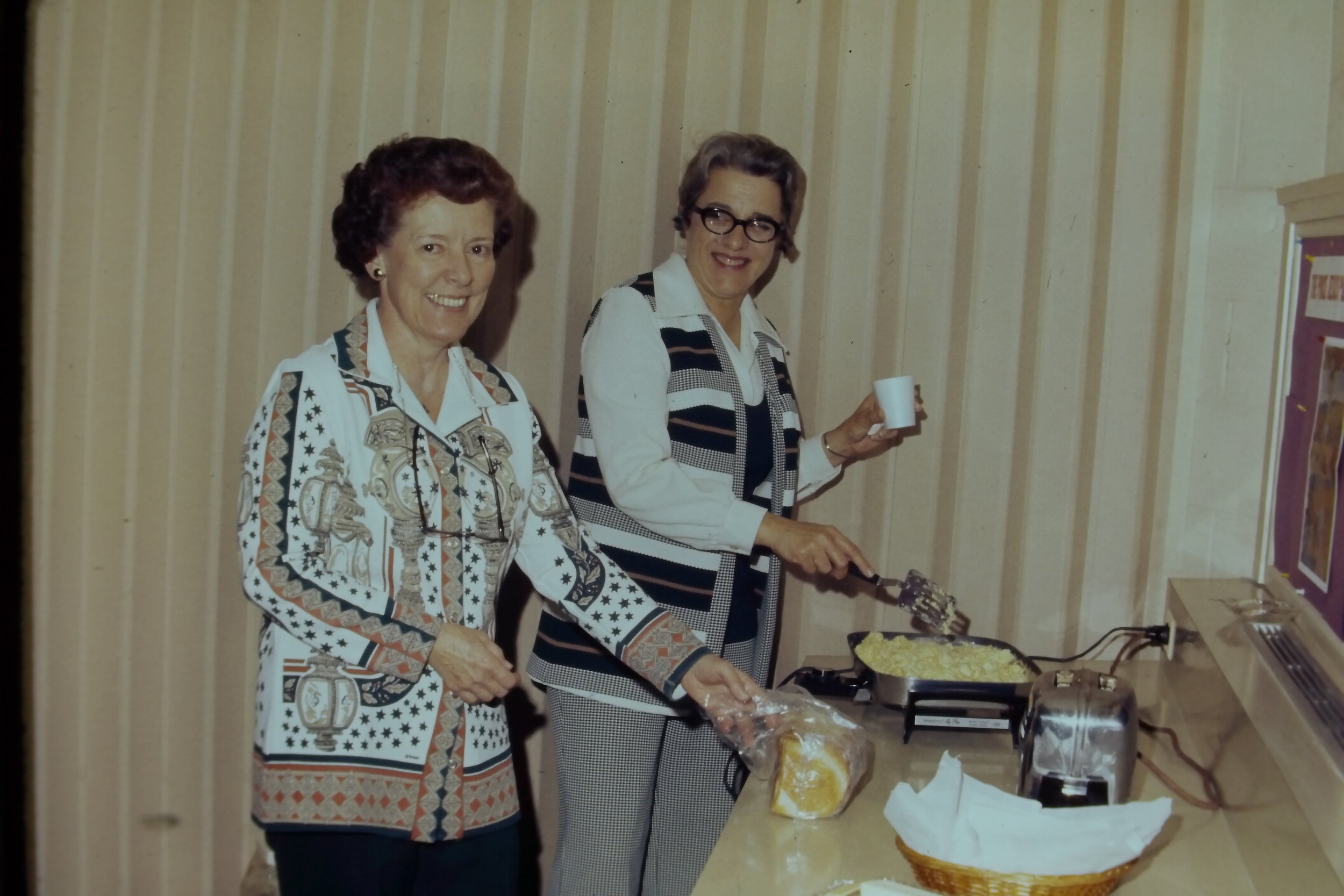
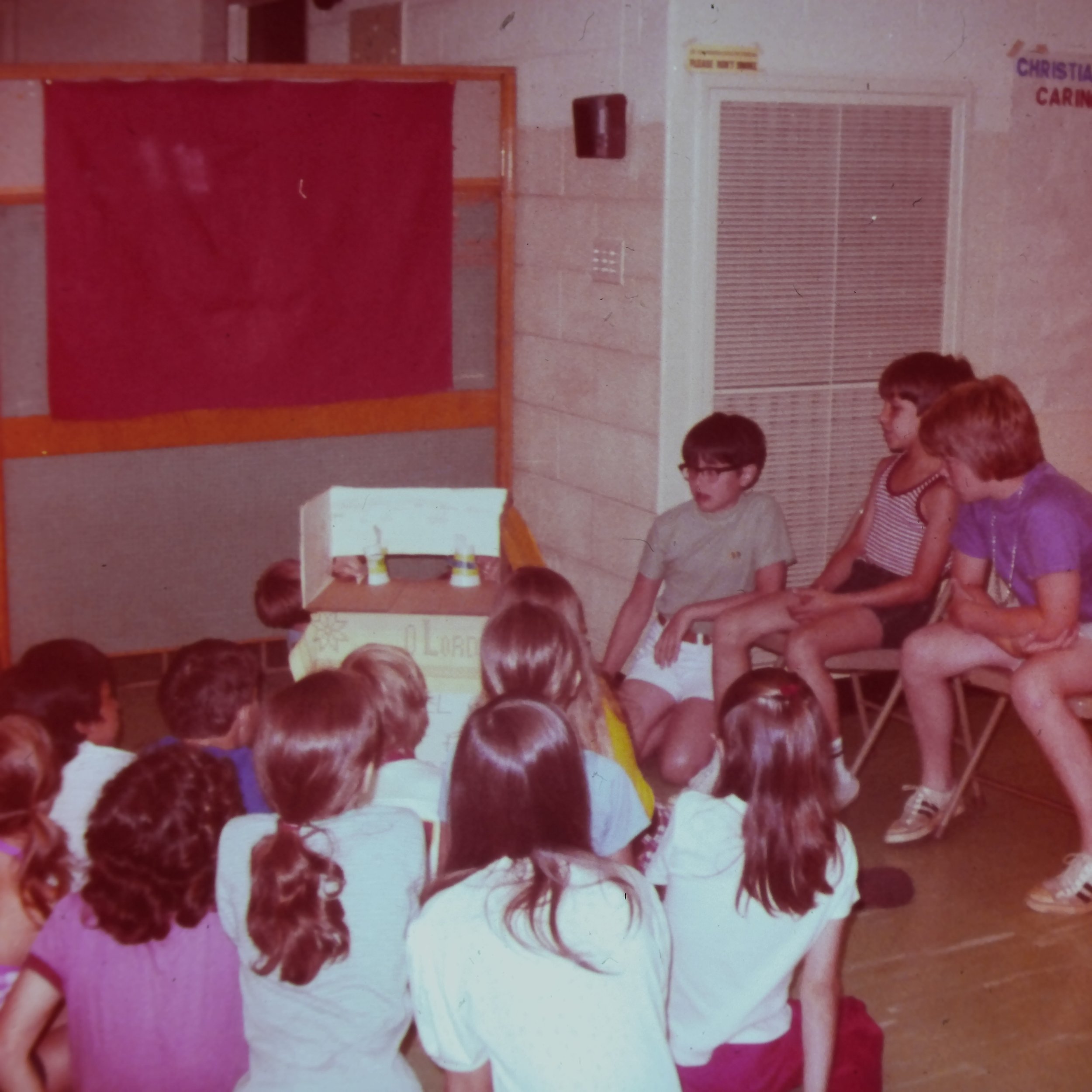
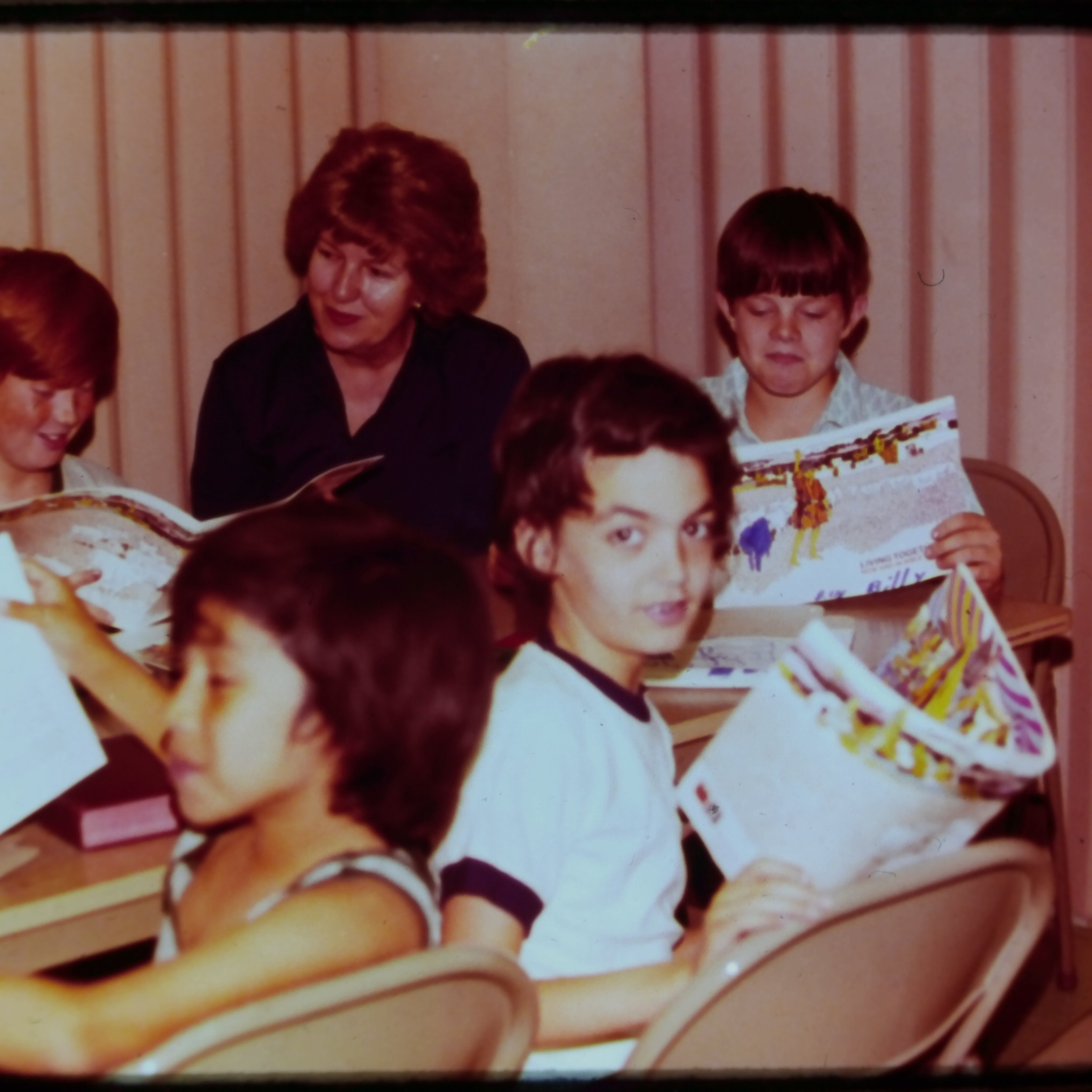
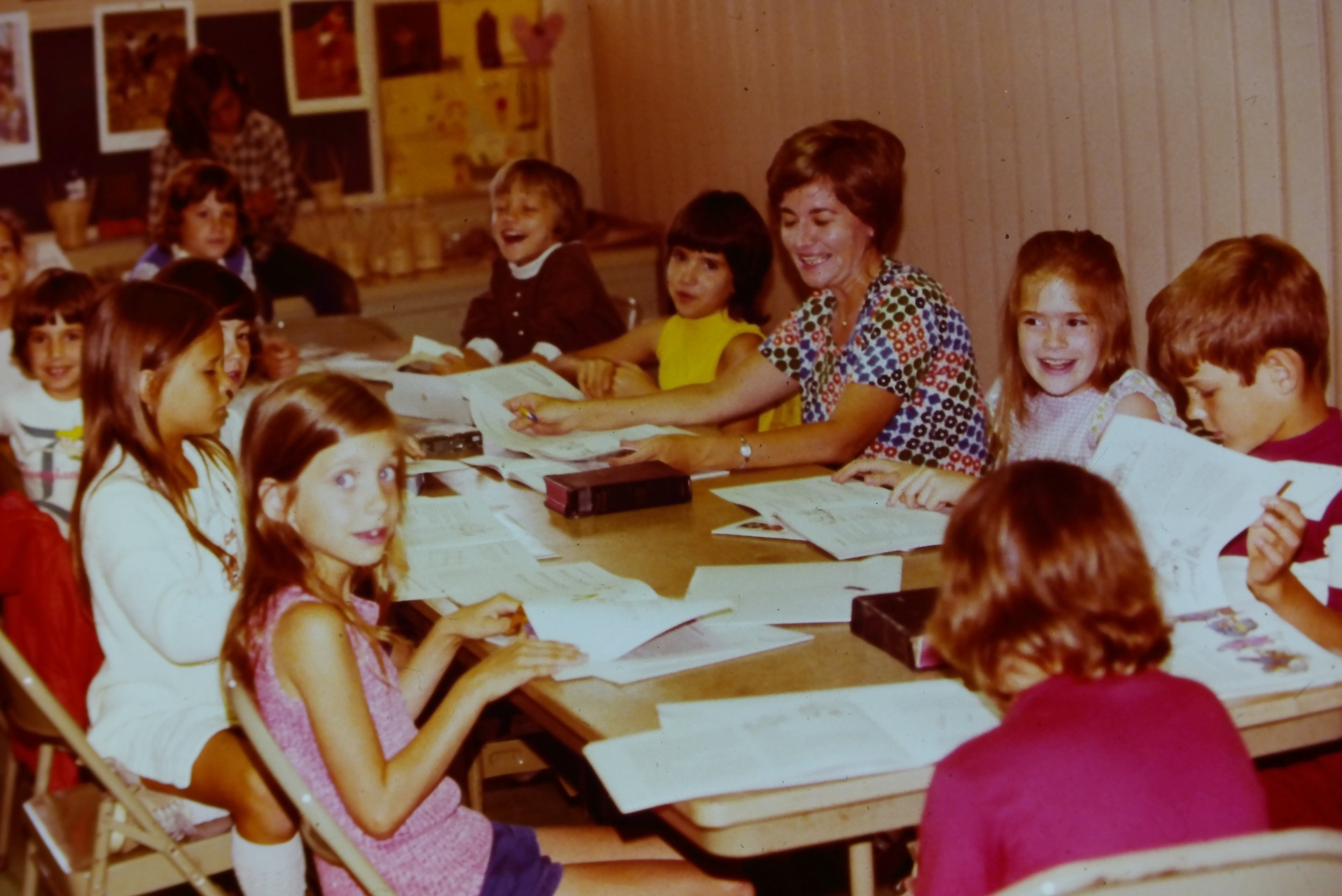
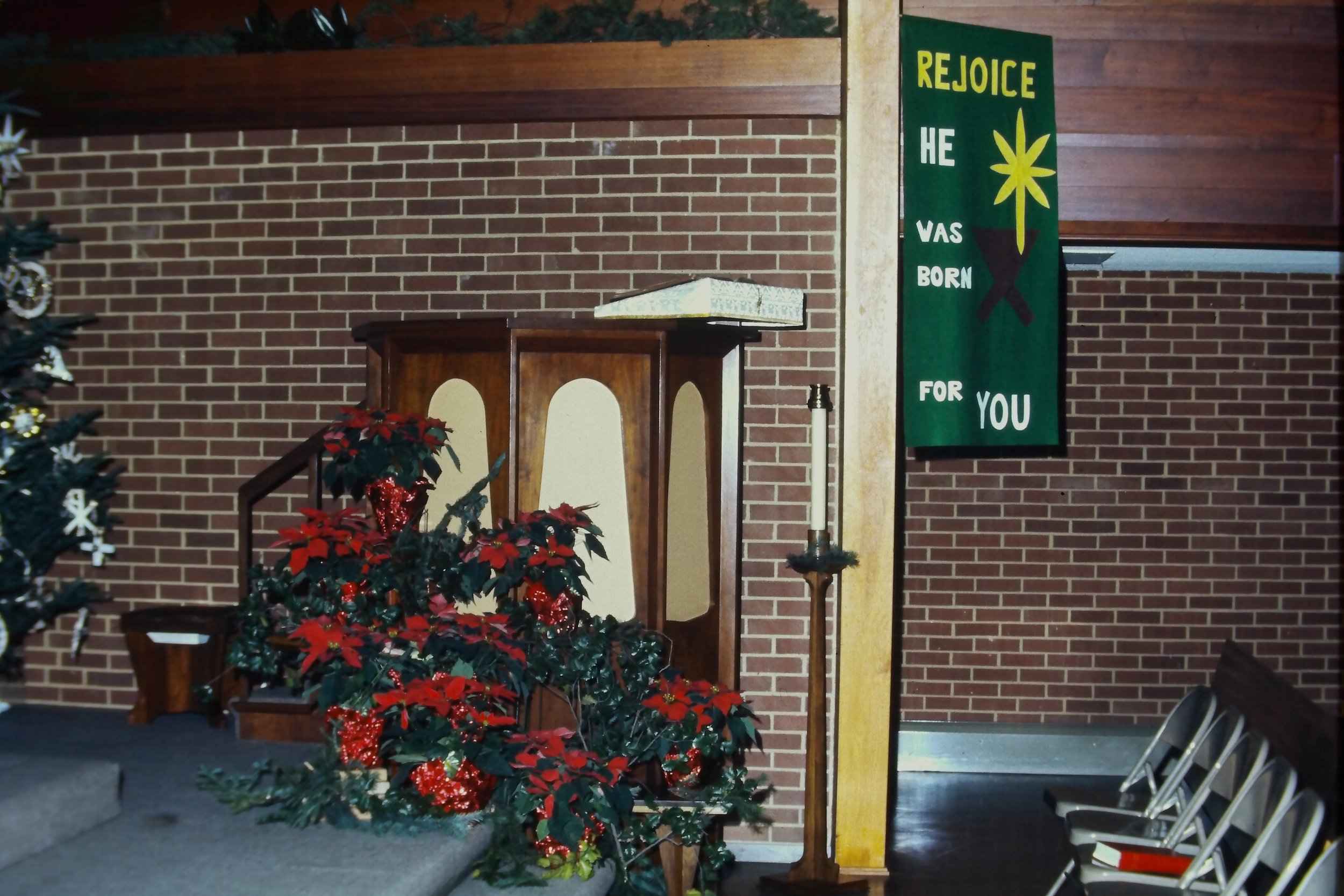
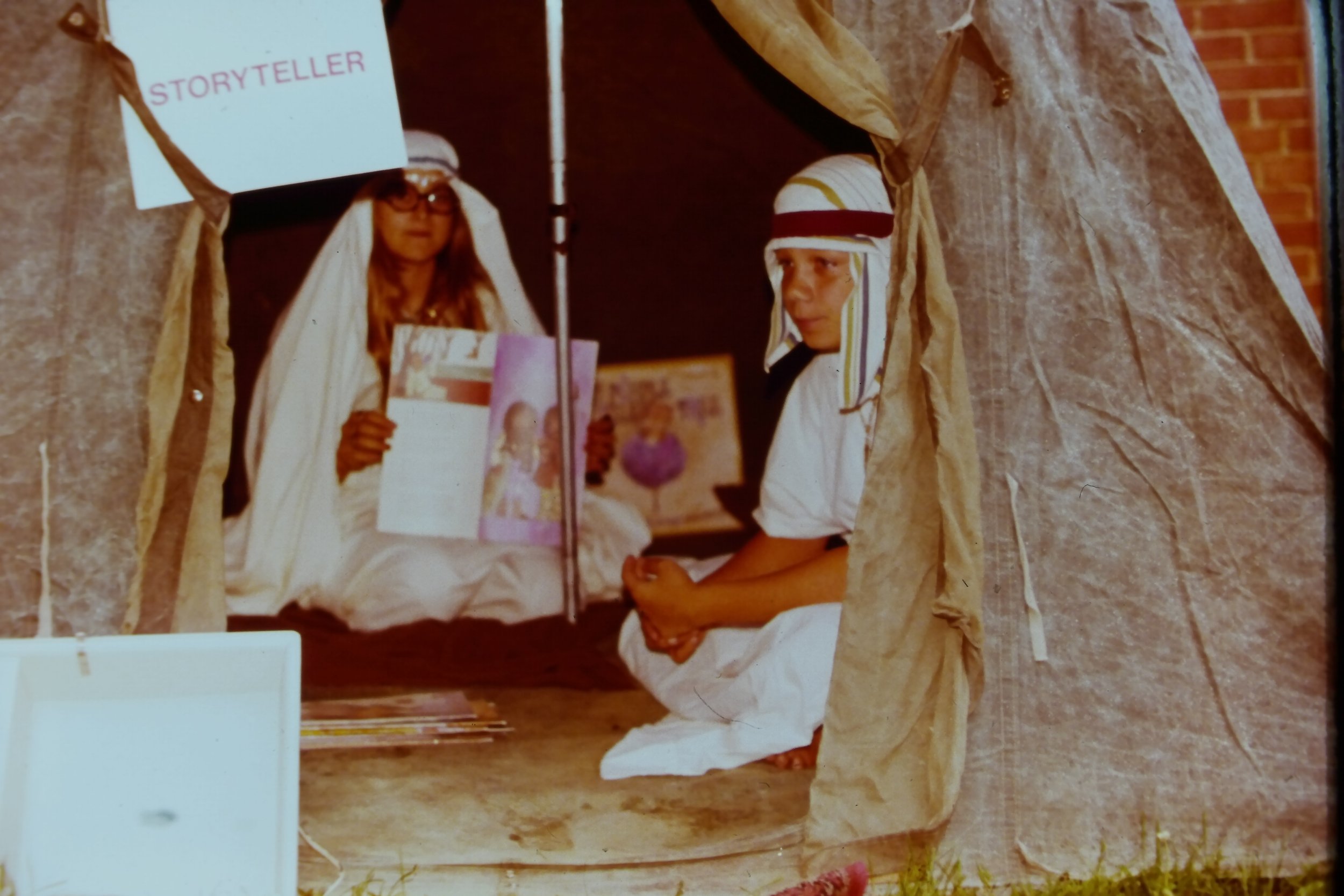
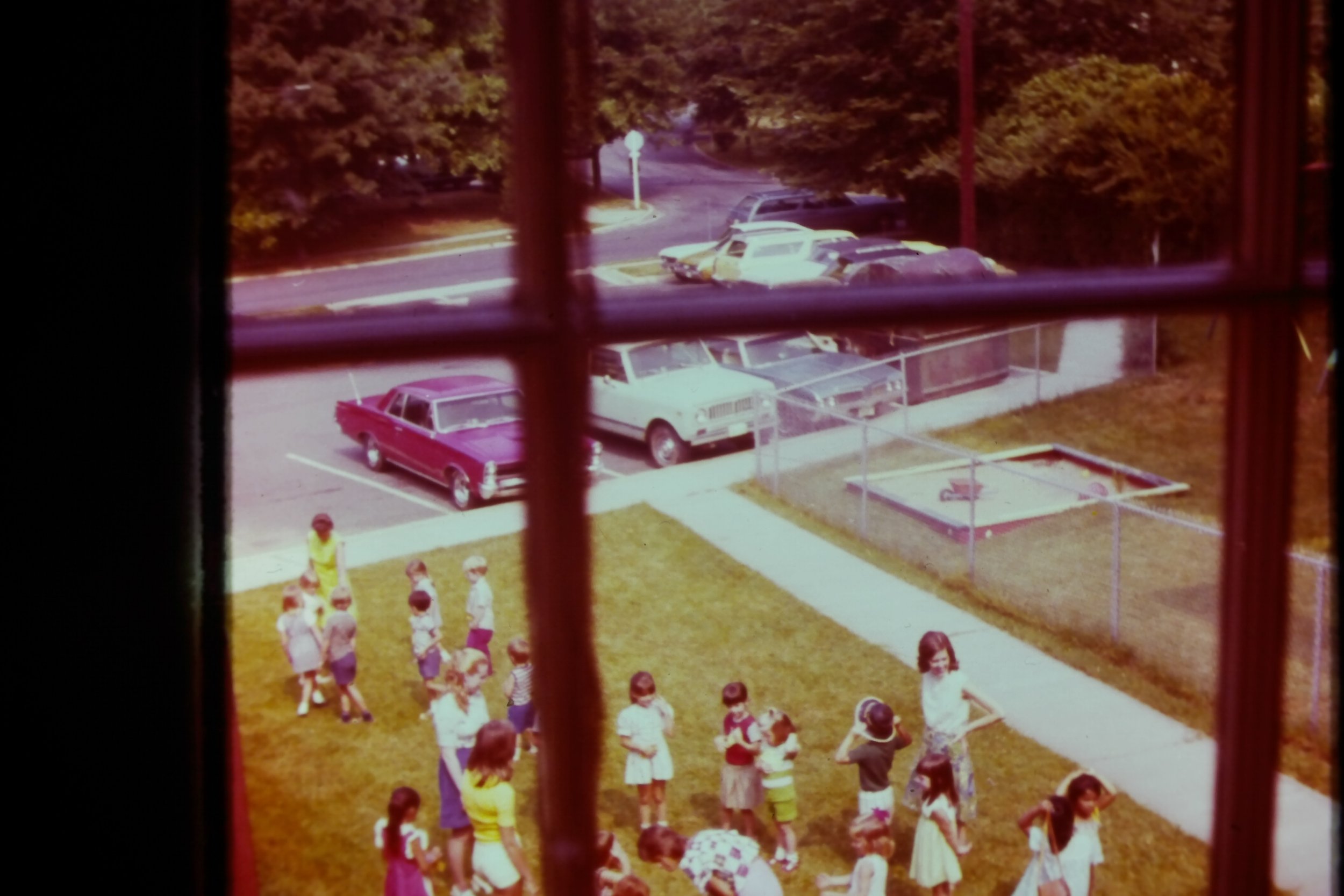
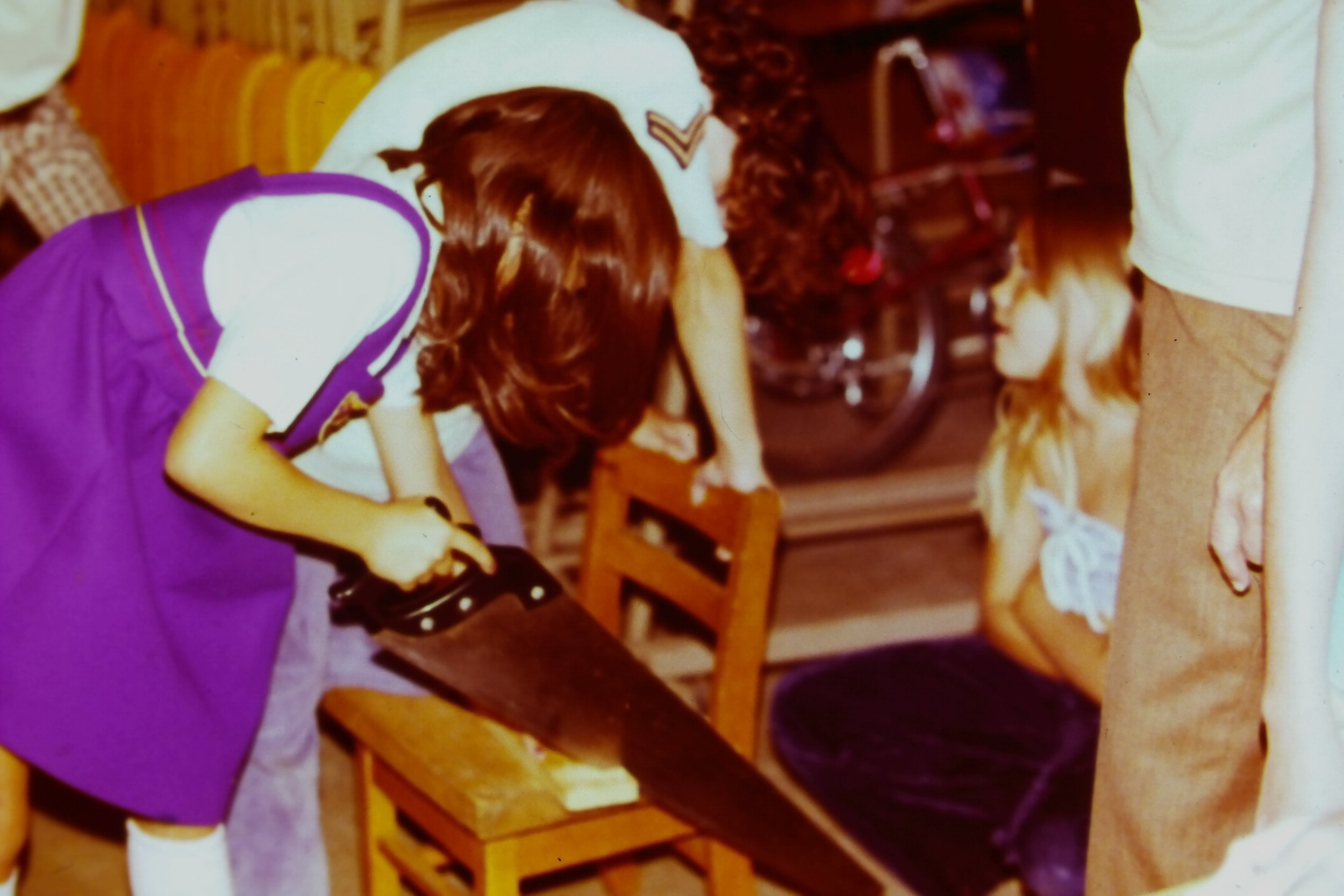
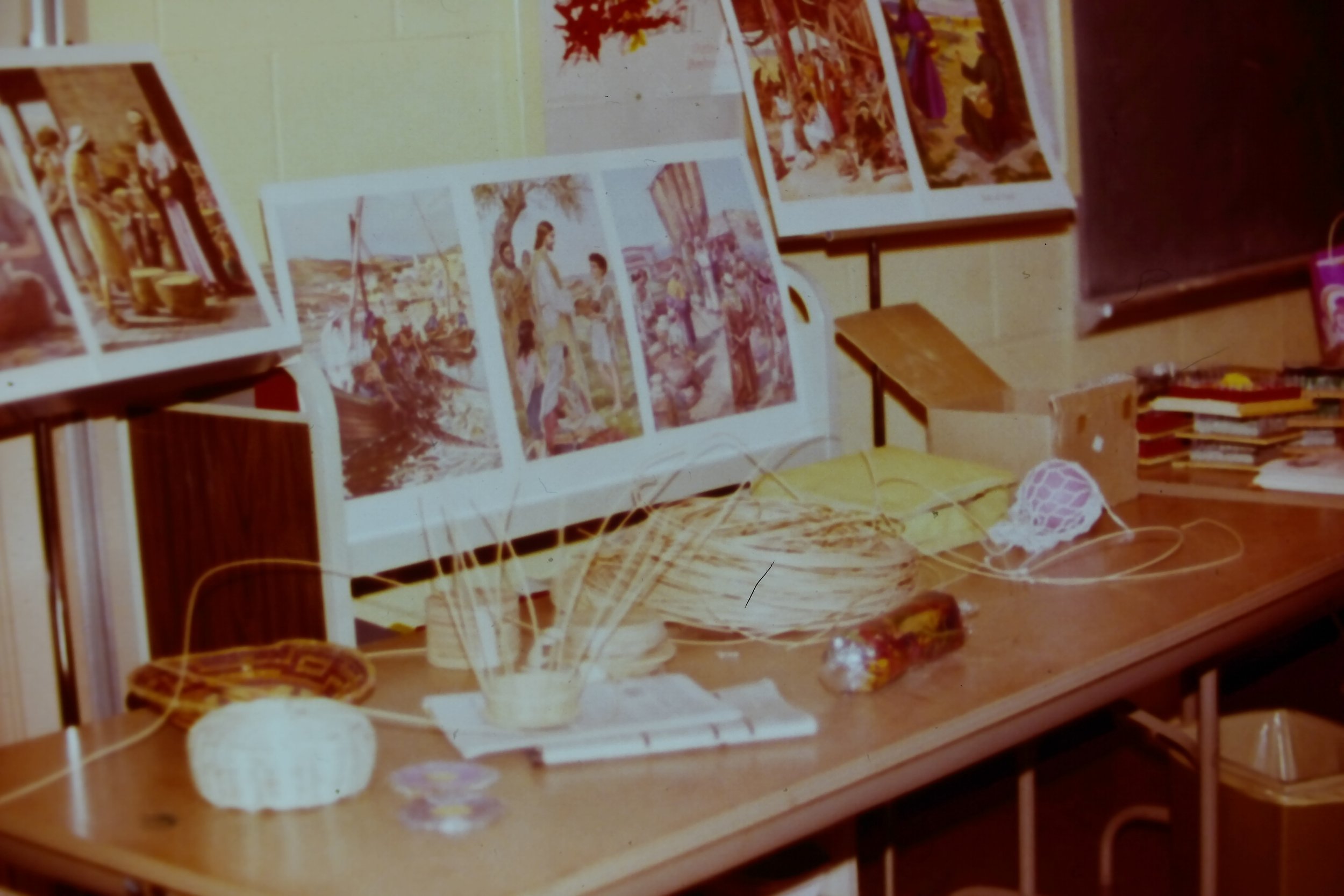

1980’s: A Time of Change
Prior to 1980, worship services were at 9:00 and 10:30 am, with Sunday School classes during both services. On September 7, 1980 the worship services were changed to 8:30 and 11:00 with the Sunday School program between the services at 9:45. This not only allowed children to attend services with their parents but, also afforded adults a better opportunity to attend Sunday School, with the result that adult Sunday School attendance increased 300% in the 80’s.
On August 10, 1980, after serving Holy Trinity for 10 years, 5 years as Senior Pastor, Pastor Langholz accepted a Call to Grace Lutheran Church in Clearwater, Florida. Pastor Larry Cantu was called to be Senior Pastor from St. John’s Lutheran Church, Mars, Pennsylvania. Pastor Cantu preached his first sermon on April 26, 1981 and was installed as our fourth Senior Pastor on May 31, 1981. He would serve as Pastor until 2000. During the interim period from August 1980 until April 1981, Pastor Larry Shoberg served as interim pastor. At this time, Holy Trinity had 1240 baptized members.
On October 10, 1982, after serving Holy Trinity for 4 years as assistant pastor, Pastor Swonger accepted a call from Messiah Lutheran Church, Twin Lakes, Wisconsin. The position of assistant pastor was changed to associate pastor with the call of Pastor Arnold Holgersen from St. Paul’s Lutheran Church, Beaver Falls, Pennsylvania. He was installed on September 4, 1983. On November 20, 1983, Holy Trinity held a mortgage-burning celebration to commemorate the final payment on the Church building and parsonages.
In September 1983, Jason Burns was hired to the lay position of Director of Youth Ministries after completing his seminary training and a one-year internship at Faith Lutheran Church in Arlington, VA. In January 1984, Holy Trinity gave Jason Burns a three year call as Youth Minister. On February 26, 1983, Pastor Burns was ordained at St. Paul’s Lutheran Church, Fulton, MD, and on March 11, 1984 was installed as Holy Trinity’s Youth Pastor. On March 22, 1987, Pastor Burns accepted a call to Trinity Lutheran Church in East Rochester, New York.
On November 22, 1987, Pastor Holgersen accepted a call from Shepherd of the Valley Lutheran Church, Harrisonburg, Virginia. Pastor Craig Endicott was called to the associate pastor position from Community Lutheran Church, Sterling, VA. Pastor Endicott began his ministry here on July 11,1988, and was installed on September 18.1988. During the interim period, Pastor Ralph Piper, recently retired to our area from Youngstown, Ohio, served as interim associate pastor and was named pastor emeritus on May 12, 1988.
Holy Trinity was originally founded as part of the American Lutheran Church (ALC). In 1988, the ALC merged with the Lutheran Church in America (LCA) and the Association of Evangelical Lutheran Churches (AELC) to become the Evangelical Lutheran Church in America (ELCA) . Now the ELCA is one of the largest Christian denominations in the US, with nearly 3.3 million members in more than 8,900 worshiping communities across the 50 states and in the Caribbean region.
In 1988 during this transition to an ELCA church, Holy Trinity had 1,165 baptized members and a church school enrollment of 175. Through the 80s and 90s, Holy Trinity had a number of fellowship activities including Young Couples group, singles group, Fellowship Club, and family retreats at Caroline Furnace. The space in the back of the house was made available for additional parking. It also became the space for Holy Trinity’s memorial wall and garden, which were put in place in 1995.
In 1989, the house and parcel of land at 7017 Aronow was purchased and designated as a parsonage. An open-ended lease was signed in May 1990 with Bethany House of Northern Virginia, to use the former parsonage at 7019 Aronow as a shelter for abused spouses.
THE further development of the music PROGRAM
In May 1982, Holy Trinity completed the final phase of a three phase installation of its 1574 pipe Lewis and Hitchcock pipe organ. The first phase was dedicated in May 1966, with 8 ranks containing 555 pipes; the second phase was an expansion to 15 ranks of 1140 pipes in May 1978.
In 1982 Tom and Marilyn Gannon started directing the adult handbell program, the Christus Bells; in 1983 formed the Luther Ringers for the teens; and in 1984 added grade-school age choirs. In 1985, the fifth octaves of bells was purchased which completed the full set of 61 bells. Three octaves of Choirchimes were also purchased in 1985 for use with the children’s choir.
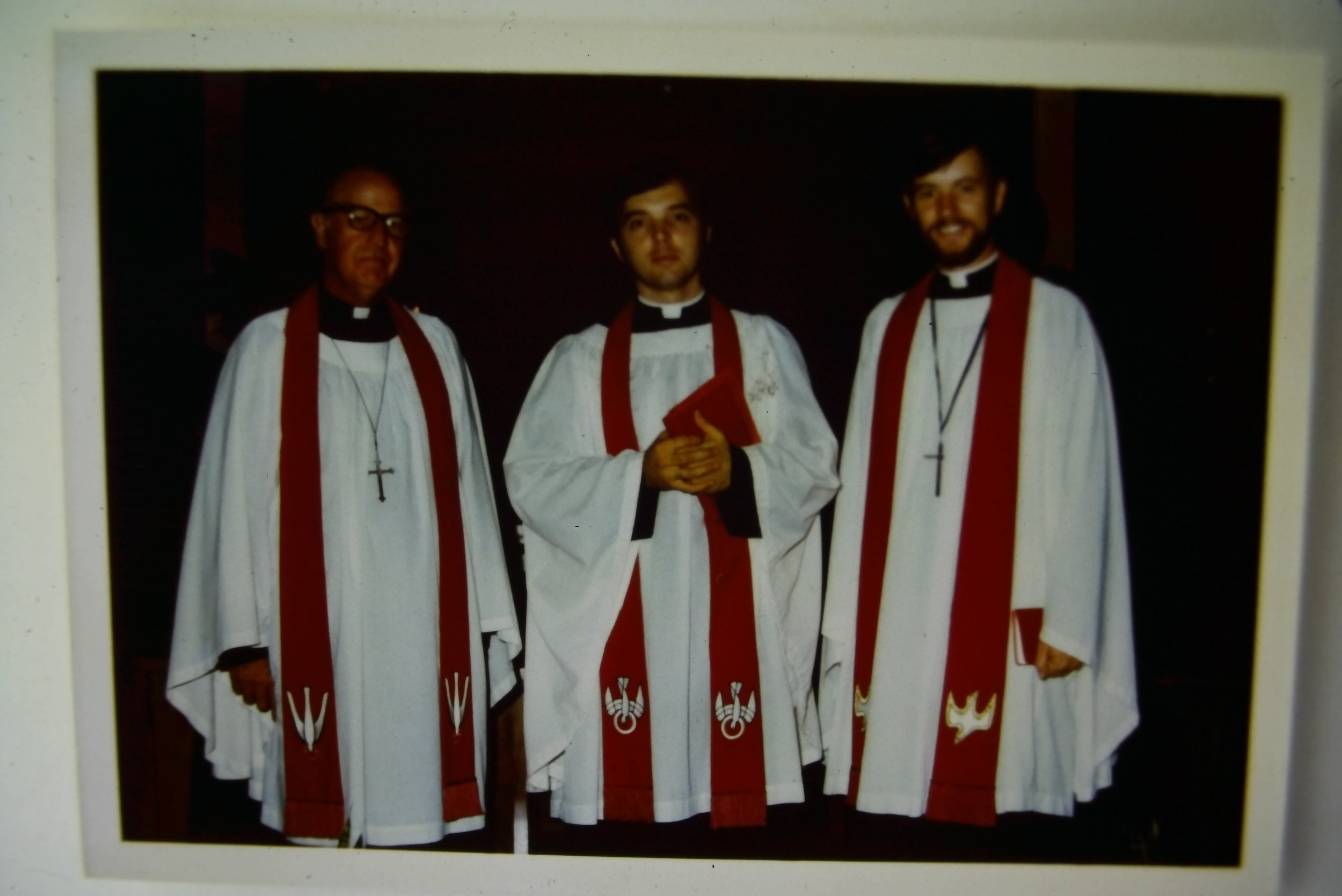
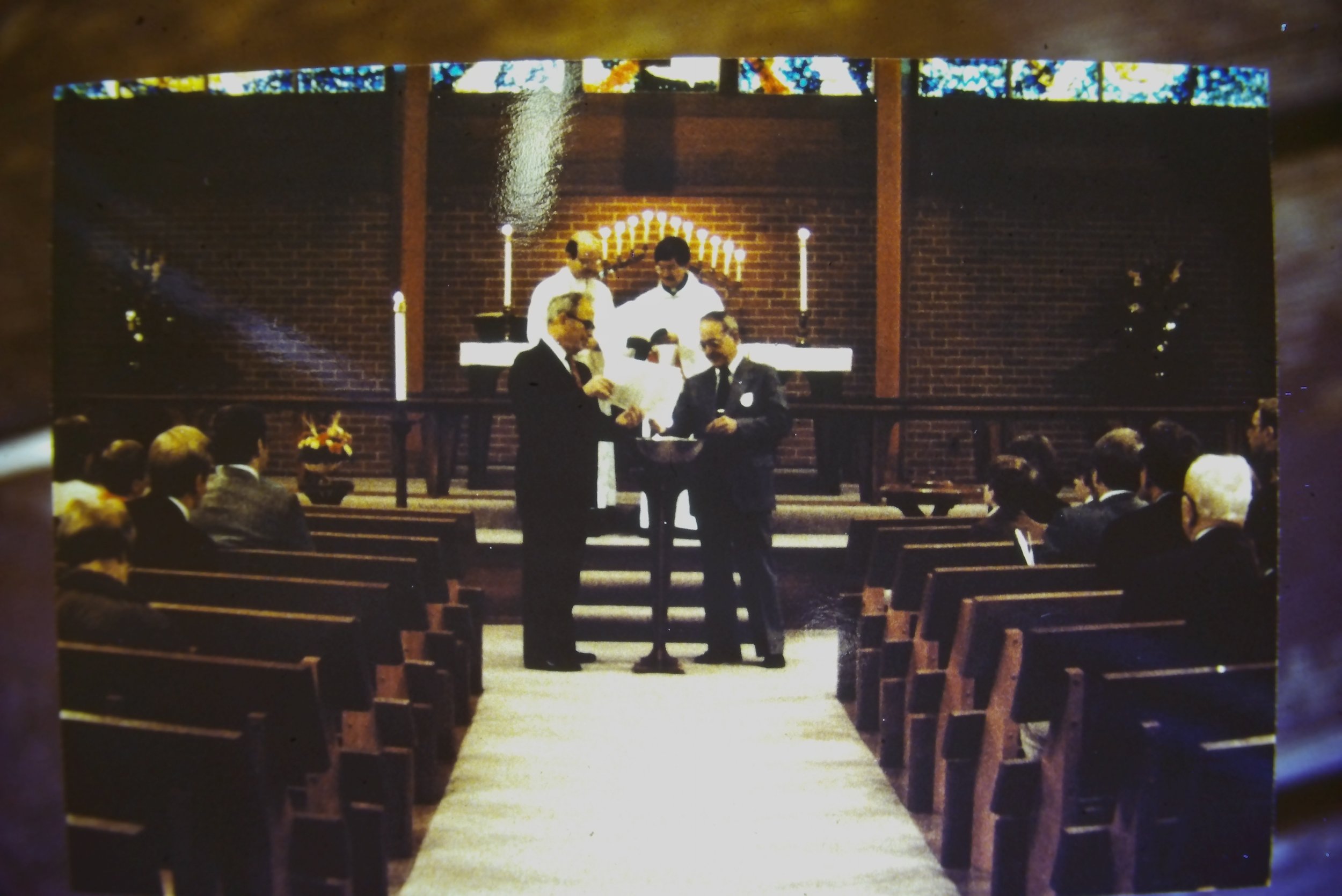
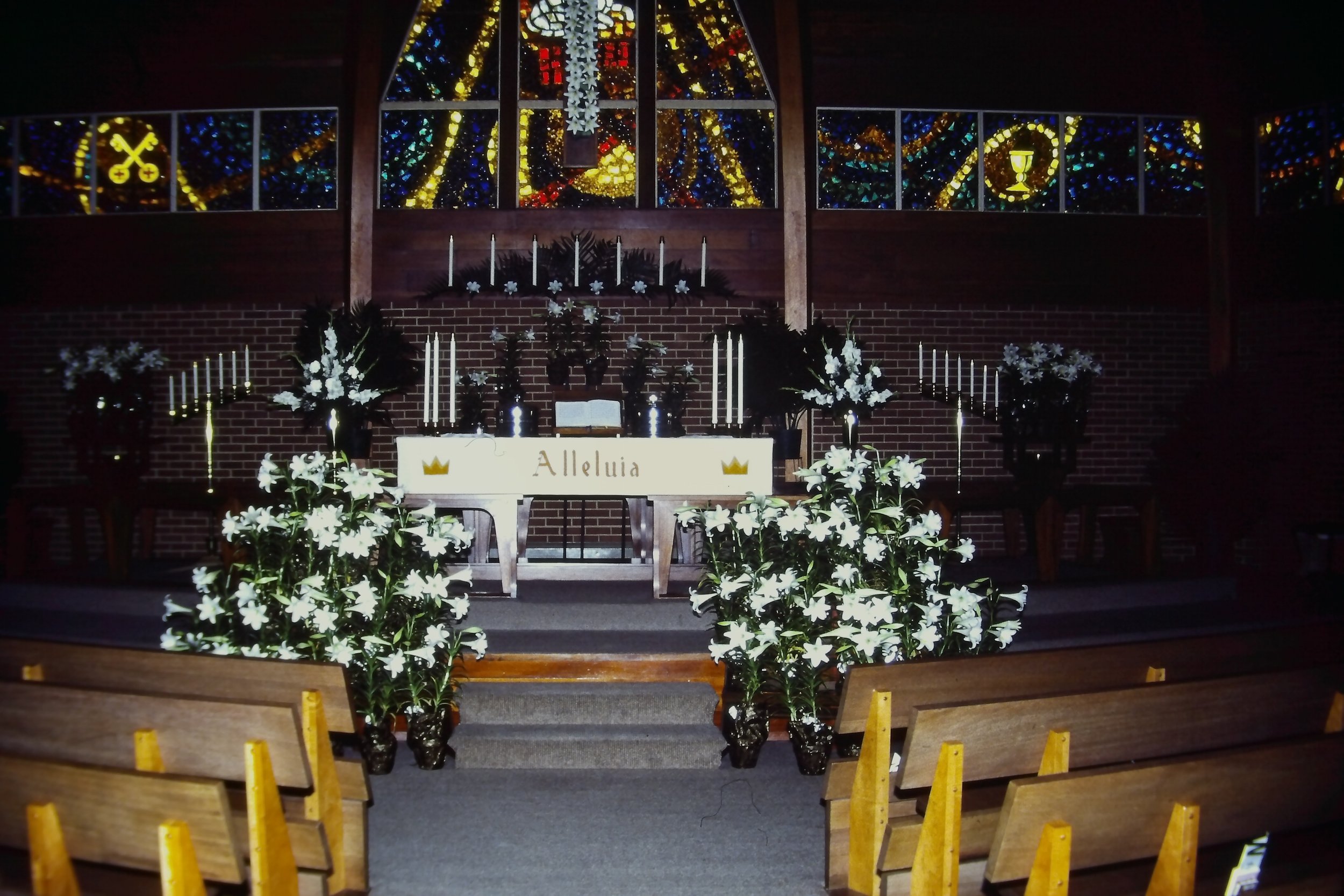
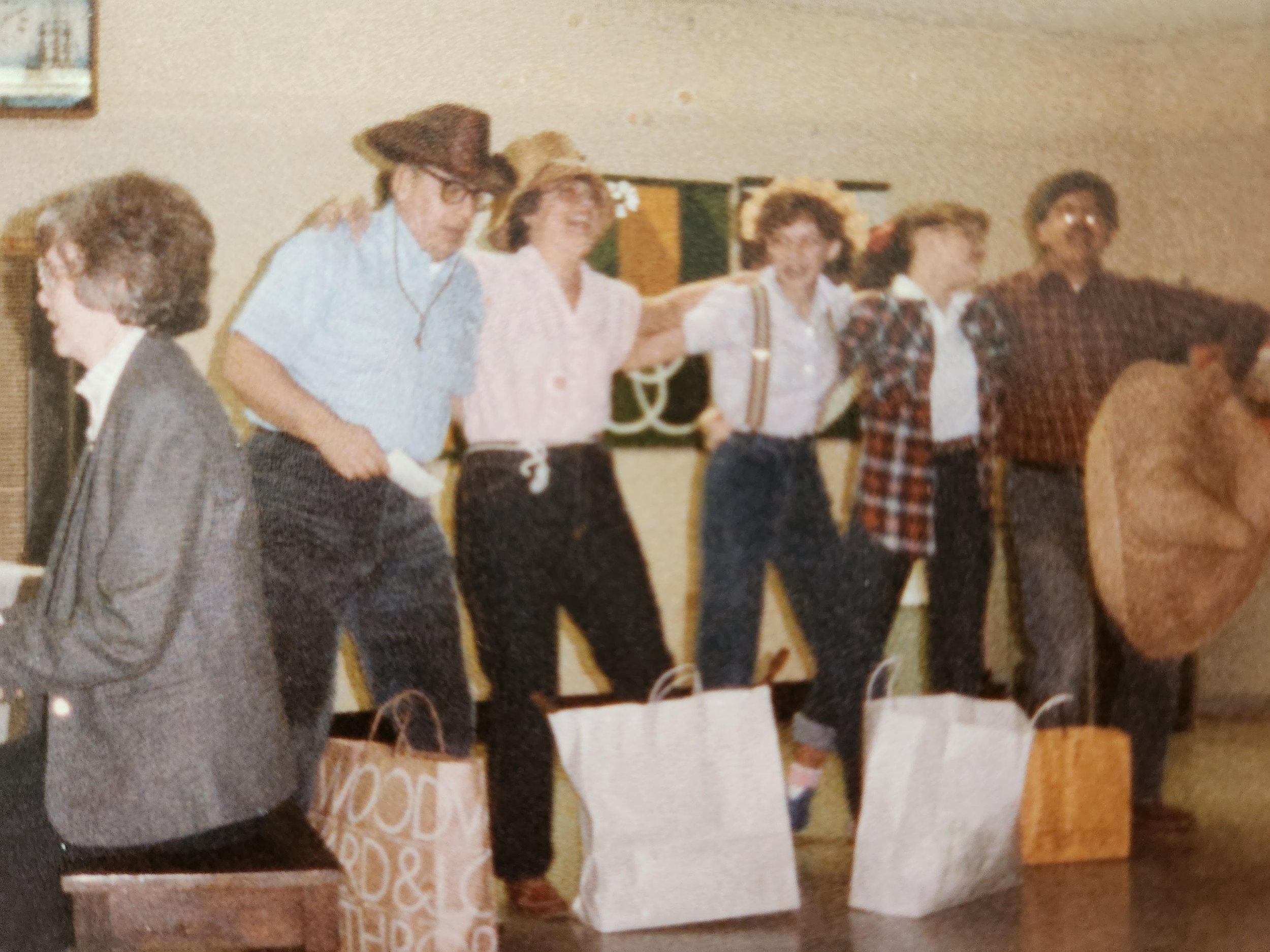
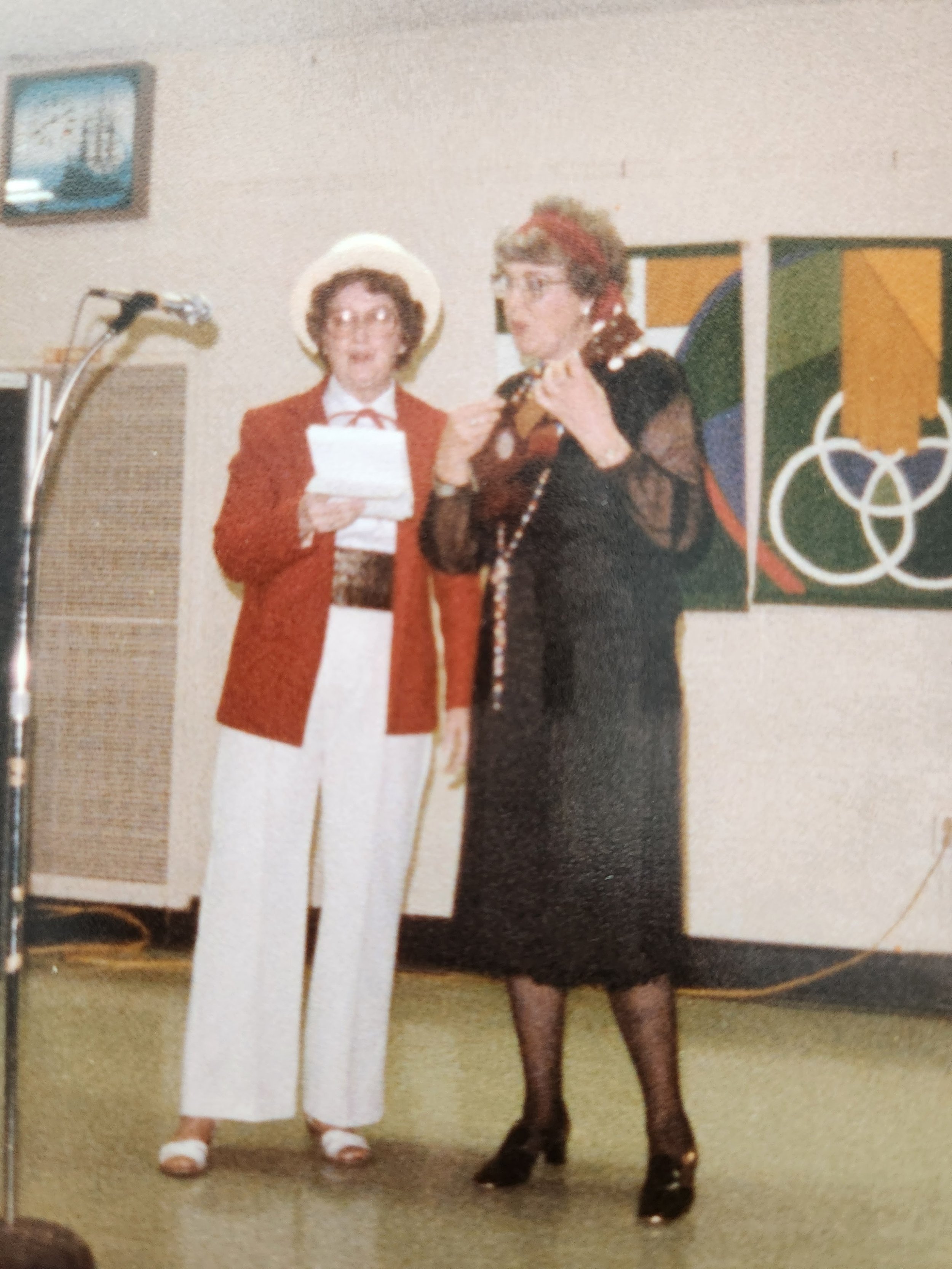
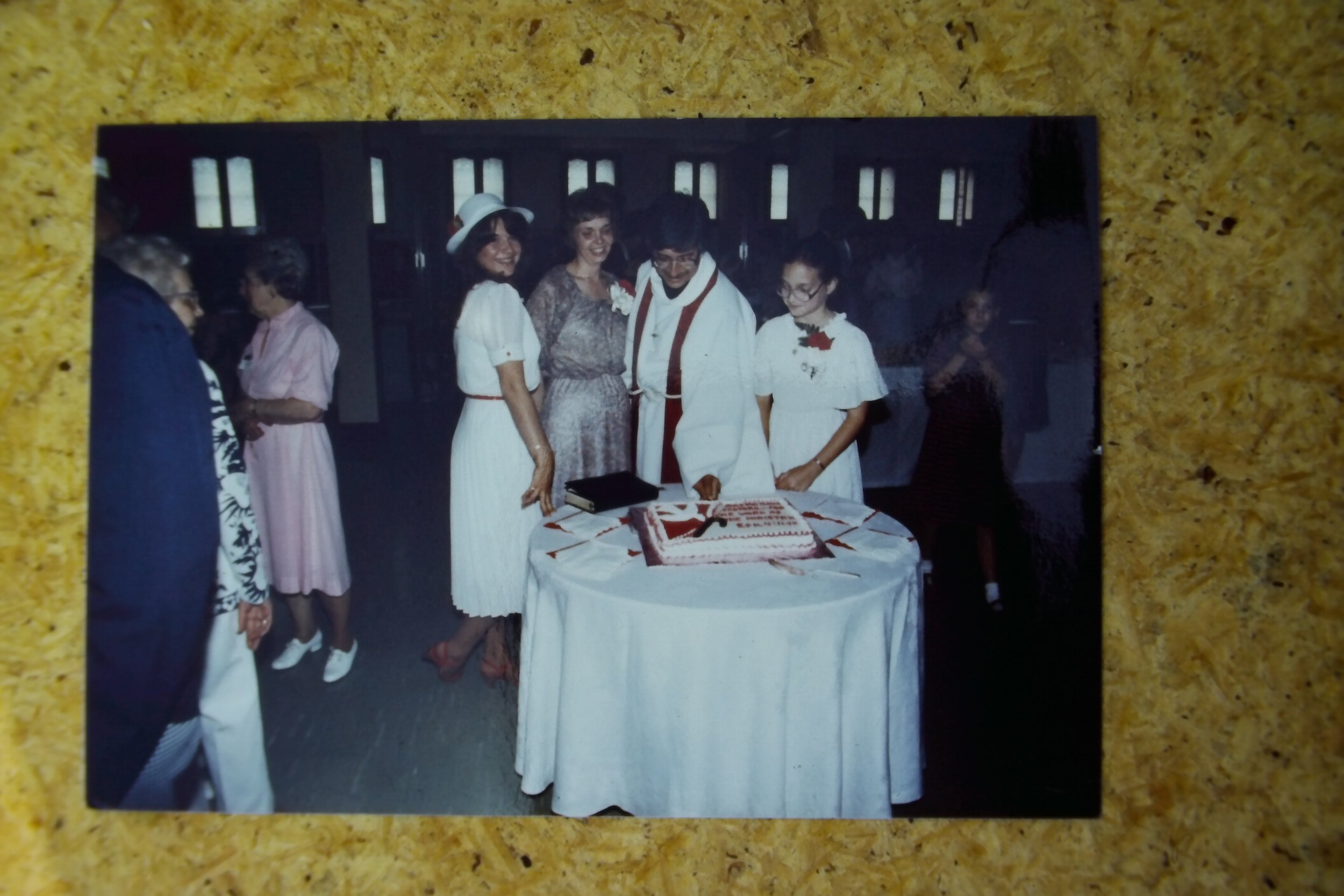
1990’s
In 1993 Holy Trinity re-established its internship program with Trinity Lutheran Seminary in Columbus, OH. This once again provided Holy Trinity with student ministers for one year of learning experience while serving at Holy Trinity. It was continued for six more years. The seminary students who have served in the capacity of Vicar (intern) were: Kelli Shephard, Tyson Wood, Douglas Ryniewicz, our present Pastor, Jeffrey Lindsey, Scott Seeke, and Jerry Johnson. Holy Trinity also began hosting a Vietnamese Mennonite Congregation in its facilities.
Also in 1993, Holy Trinity began hosting a Vietnamese Mennonite Congregation in its facilities. That congregation is still meeting at Holy Trinity today. For many years, Holy Trinity’s congregation and the Vietnamese congregation shared a service at an annual summer picnic. For a time in the 1990’s Holy Trinity opened its doors to a Spanish-speaking congregation, which met at Holy Trinity on Saturdays. During this time, Holy Trinity members volunteered their time to help Spanish speakers learn English.
Holy Trinity has enjoyed its participation in the Vicar (intern) program of the ELCA. It is also proud of three Sunday School Students, confirmed at Holy Trinity, active in the Luther League and Youth Choirs that went on to make the ministry their life’s calling. Two of them were ordained at Holy Trinity; Douglas Adams in July 1975 and David Stickley, in August 1978. Connie Thomson was ordained at Trinity Lutheran Church, Madison, WI, in June 1993.
In August 1998, Holy Trinity welcomed Assistant Pastors Bill and Jenni Zima. Both were graduates of Lutheran Southern Seminary in Columbia, SC. Bill was called to work with the Youth and Outreach Programs, while Jenni’s responsibilities included Worship and Pastoral Care. Having served Holy trinity for almost four years in May 2002, they accepted calls to Lutheran Chapel Church in Gastonia, NC.







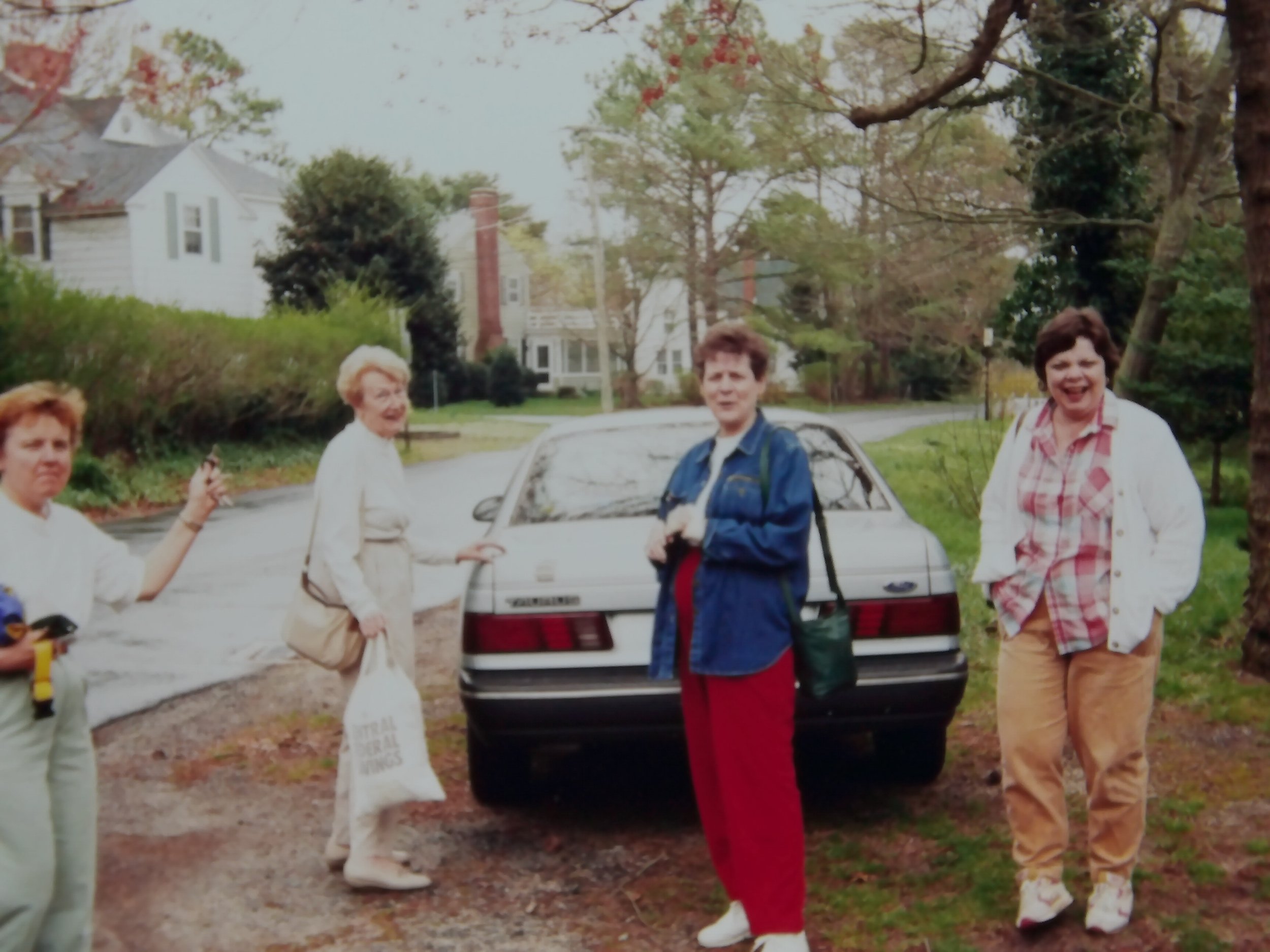










2000’s: Expansion
Having served the ministry at Holy Trinity faithfully for 19 years, in June 2002, Pastor Larry Cantu retired and moved to Petersburg, WV, where he continues serving in several interim pastoral roles. In January 2001, the Rev. Dr. John Bengston accepted Holy Trinity’s call as Interim Senior Pastor at Holy Trinity, serving faithfully until June 2002. Pastor Bengston was instrumental in leading Holy Trinity to stretch its mission outreach. It was extended as far as the ELCA Synod in Malawi, Africa, to which Holy Trinity financially provided for a desperately needed mobile medical clinic.
With the acceptance of Holy Trinity’s call by Pastor Douglas Ryniewicz, Pastor Bengston moved on to further serve as interim pastor at All Saints Lutheran Church in Bowie, MD. In July 2002, Pastor Doug Ryniewicz accepted Holy Trinity’s call and arrived in Falls Church with his family, moving into the Senior Pastor parsonage at 7002 Aronow Drive. Pastor Ryniewicz preached his first sermon on August 4, 2002 (having previously preached as a vicar between August 1995 and August 1996). On November 17, 2002, he was installed as Holy Trinity fifth Senior Pastor. Pastor Doug accepted a call and moved to the New England region in 2006.
In September 2003, Pastor Jane Halpern was called to be Holy Trinity’s Associate Pastor to serve among and with the people of Holy Trinity Lutheran Church. Pastor Jane is married to Paul, has two grown children and 3 grandchildren. She was installed on Sunday, March 14, 2004.
In 2006 there were four bell choirs playing 5.5 octaves of bells, 69 bells, plus six octaves of chimes, 73 chimes. At the turn of the century, our bell choirs’ primary purpose was playing for worship services and concerts, while our children’s choirs also taught music and bell techniques.
Since the handbells began, our choirs have played at the White House holiday open house, two Lutheran National Youth Gatherings in Denver and San Antonio, two receptions for the Washington Ballet for the Nutcracker Ballet, Kennedy Center festival, programs for the American Guild of Organists, Hospice Memorial program, national convention of the American Bell Collectors Association, playouts at shopping centers and nursing homes, several weddings, plus numerous worship services and concerts at other churches. Handbell festivals provide playing experience with other choirs and music classics, plus the opportunity to be together.
Lineage of Leadership
Holy trinity PASTORS
William Zima; Assistant Pastor 1998-2002
John W. Bengston; Interim Pastor 2001-2002
Brent Thalacker; Interim Pastor 2002
Douglas Ryniewicz; Pastor 2002-2006
Jane Halpern; Associate Pastor 2003-2007; Pastor 2007-2015
Jim Heinemeier; Interim Associate Pastor 2006-2007
Margrethe Kleiber; Assistant Pastor 2008; Associate Pastor 2010-2012
Tom Montgomery; Interim Pastor 2015
Krista Vingelis; Pastor of Youth and Family Ministry 2017-2018
Heidi Eichstadt; Pastor of Youth and Family Ministry 2021-2022
Michael Gutzler; Pastor 2015-present
Edward F. Yost; Pastor 1948-1963
William L. Nies; Pastor 1963-1974
Douglas Langholz; Assistant Pastor 1970-197; Pastor 1975-1980
Stephen DeGweck; Assistant Pastor 1975-1978
Steven Swonger; Assistant Pastor 1978-1982
Larry Shoberg; Interim Pastor 1980-1981
Larry M. Cantu; Pastor 1981-2000
Arnold Holgersen; Associate Pastor 1983-1987
Jason Burns; Youth Pastor 1984-1987
Craig Endicott; Associate Pastor 1988-1998
Ralph Piper; Pastor Emeritus 1990-1998
Jennifer Zima; Assistant Pastor 1998-2002
Holy Trinity Vicars
Donald McCash 1966-1967
Timothy Nehis 1967-1968
Richard Gilbert 1968-1969
Richard Browder 1969-1970
Kelli Shepard 1993-1994
Tyson Wood 1994-1995
Douglas Ryneiwicz 1995-1996
Jeff Lindsay 1997-1998
Scott Seeke 1998-1999
Gerard Johnson 1999-2000
Laura Johnson 2008-2009
Daniel G. Shantu 2009-2010
Suzanne M. Stierwalt 2013-2014
Daniel Rinehart 2016-2017
Cory Bergman 2018-2019
Allison Vincent-Beckman 2022-2024



